
Cast * Interesting Facts * Behind the scenes * Interview with producer Don Hahn * Sequel * The Fire Mountain * Similarities with Nadia

Cast * Interesting Facts * Behind the scenes * Interview with producer Don Hahn * Sequel * The Fire Mountain * Similarities with Nadia
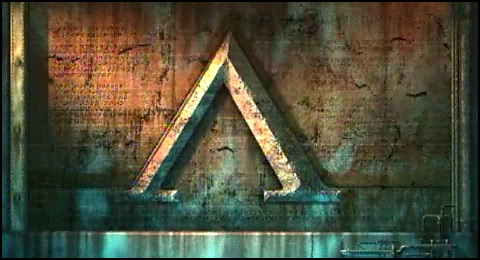 |
 |
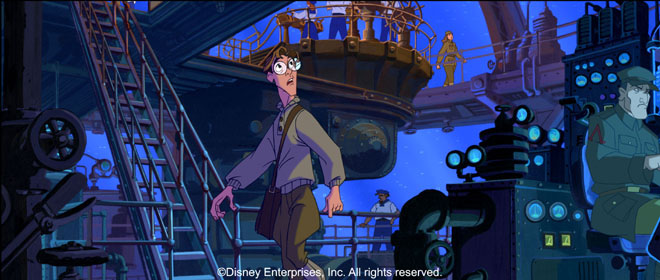 |
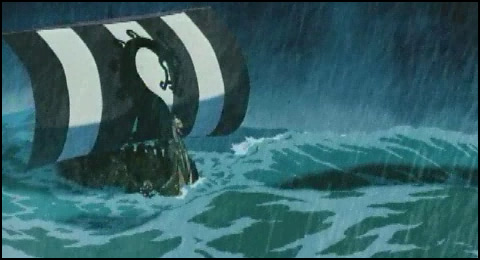 |
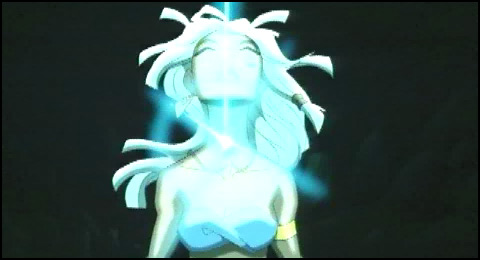 |
Directed by: Gary Trousdale & Kirk Wise
Written by: Tab Murphy (Tarzan)
Score: James Newton Howard
Production started on: March 16, 1998; rough animation was completed by July 2000
Release Date: June 15, 2001
Running Time: 95 minutes
Budget: $90 million officially (but $120 million rumored)
U.S. Opening Weekend: $20.342 million (3,011 screens)
Box-Office: $84.04 million in the U.S. (plus $130 million from
6.1 million copies sold on video and DVD), 138.60 million worldwide
Video Revenue: $156.9 million from DVD and VHS rentals and sales
 |
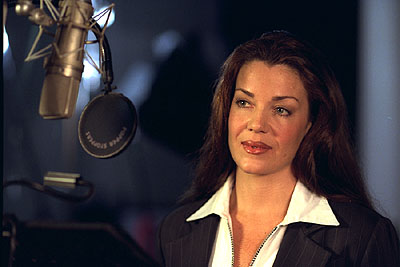 |
 |
 |
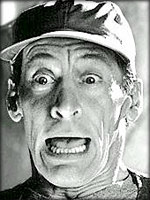 |
Milo Thatcher... Michael J. Fox
Helga Sinclair... Claudia Christian
Dr. Joshua Sweets... Phil Morris (replacing Star Wars'
Mark Hammill)
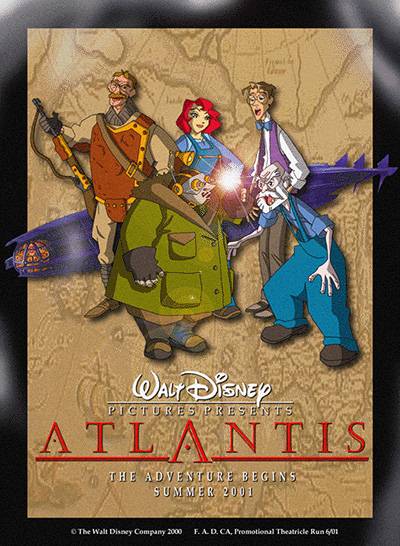 Atlantian
King... Leonard Nimoy
Atlantian
King... Leonard Nimoy
Captain Rourke... James Garder
Cookie... Jim Varney
Princess Kida... Cree Summer
Vinnie Satorini... Don Novello
Preston Whitmore... John Mahoney
Fenton Harcourt... David Ogden Stiers
![]() Kirk Wise & Gary Trousdale's first directorial effort was the "Cranium
Command" pre-show in the "Wonders of Life" pavilion at Epcot's Future World,
which debuted in October 1989. That movie has been credited by many Disney
insiders with saving what had been -up until then- a very troubled theme
park attraction.
Kirk Wise & Gary Trousdale's first directorial effort was the "Cranium
Command" pre-show in the "Wonders of Life" pavilion at Epcot's Future World,
which debuted in October 1989. That movie has been credited by many Disney
insiders with saving what had been -up until then- a very troubled theme
park attraction.
![]() Jim Varney died at the age of 50 on February 10, 2000 of lung cancer.
As a tribute to Jim's professionalism -who even while battling cancer,
still regularly made trips to Burbank to record dialogue for Atlantis:
The Lost Empire, performing in countless sessions without complaint-,
Cookie's character was kept in this film even though all of Jim Varney's
dialogue hadn't been recorded at the time of his death. Jim also
voiced Slinky the Dog in both Toy Story
movies and acted Jed in The Beverly Hillbillies. "He was such
a great guy to work for. We did get his entire performance except for one
line in the movie," later commented producer Don Hahn.
Jim Varney died at the age of 50 on February 10, 2000 of lung cancer.
As a tribute to Jim's professionalism -who even while battling cancer,
still regularly made trips to Burbank to record dialogue for Atlantis:
The Lost Empire, performing in countless sessions without complaint-,
Cookie's character was kept in this film even though all of Jim Varney's
dialogue hadn't been recorded at the time of his death. Jim also
voiced Slinky the Dog in both Toy Story
movies and acted Jed in The Beverly Hillbillies. "He was such
a great guy to work for. We did get his entire performance except for one
line in the movie," later commented producer Don Hahn.
 |
 |
 |
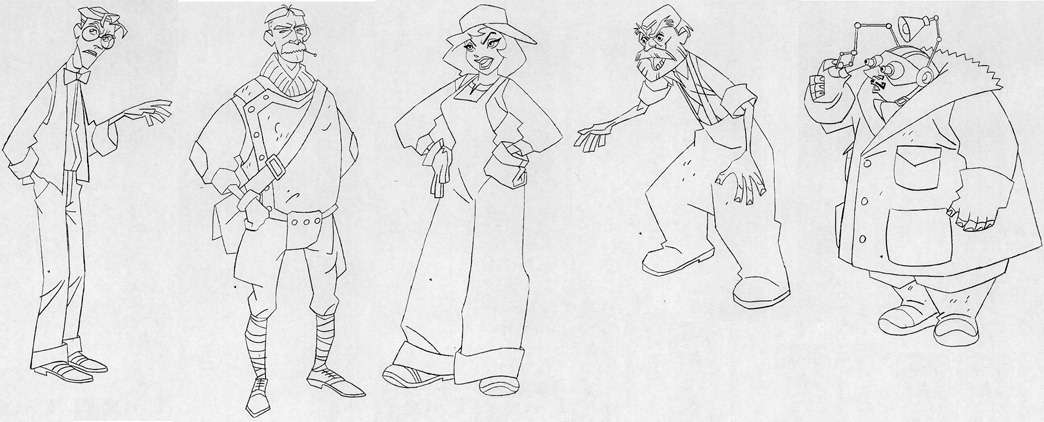 |
 |
![]() Atlantis
is Disney's first 70mm animated film since 1985's The
Black Cauldron; other Disney Features that have been in the 70mm
format: Lady
and the Tramp (1955) and Sleeping
Beauty (1959).
Atlantis
is Disney's first 70mm animated film since 1985's The
Black Cauldron; other Disney Features that have been in the 70mm
format: Lady
and the Tramp (1955) and Sleeping
Beauty (1959).
![]() The project
initially started as an animated version of Jules Verne's Journey
to the Center of the Earth. But directors Wise and Trousdale reportedly
lost all interest and enthusiasm with the idea of making a movie that would
have been based on that particular Verne novel after just a few months
of development, and they opted instead to go forward with an "original"
Ray Harryhausen tribute story that "borrowed" quite heavily from Jules'
Journey.
The project
initially started as an animated version of Jules Verne's Journey
to the Center of the Earth. But directors Wise and Trousdale reportedly
lost all interest and enthusiasm with the idea of making a movie that would
have been based on that particular Verne novel after just a few months
of development, and they opted instead to go forward with an "original"
Ray Harryhausen tribute story that "borrowed" quite heavily from Jules'
Journey.
![]() The earliest reference
to Atlantis is found in the work of Plato, who wrote in about 360 B.C.
that he learned of the utopian civilization from people he met in his many
travels. Plato described Atlantis as "a great and wonderful empire"
that suffered extreme earthquakes and floods and vanished thousands of
years before "in a single day and night of misfortune." Speculation
over Atlantis continued through the ages, but the myth gained mainstream
appeal when Ignatius Loyola Donnelly wrote the best-selling 1882 book "Atlantis:
The Antediluvian World." The story was part pseudoscience and part
morality tale satirizing the rampant industrialism of The Gilded Age.
"He wanted to show what happens when people turned away from spirituality
and got materialistic," said Charles E. Orser, Jr., an Illinois State University
anthropology professor. "But he also took Atlantis very seriously."
The earliest reference
to Atlantis is found in the work of Plato, who wrote in about 360 B.C.
that he learned of the utopian civilization from people he met in his many
travels. Plato described Atlantis as "a great and wonderful empire"
that suffered extreme earthquakes and floods and vanished thousands of
years before "in a single day and night of misfortune." Speculation
over Atlantis continued through the ages, but the myth gained mainstream
appeal when Ignatius Loyola Donnelly wrote the best-selling 1882 book "Atlantis:
The Antediluvian World." The story was part pseudoscience and part
morality tale satirizing the rampant industrialism of The Gilded Age.
"He wanted to show what happens when people turned away from spirituality
and got materialistic," said Charles E. Orser, Jr., an Illinois State University
anthropology professor. "But he also took Atlantis very seriously."
![]() According to the
writings of Philosopher Plato dating back to 360 B.C, "...in a single day
and night of misfortune, the island of Atlantis disappeared into the depths
of the sea."
According to the
writings of Philosopher Plato dating back to 360 B.C, "...in a single day
and night of misfortune, the island of Atlantis disappeared into the depths
of the sea."
![]() To prepare for
the production, the filmmakers visited museums to study World War I-era
clothing and machinery and toured old army installations to look at submarines
and tanks. They also traveled 800 feet underground in New Mexico’s Carlsbad
Caverns to observe the subterranean trails that would serve as the model
for the approach to Atlantis in the film.
To prepare for
the production, the filmmakers visited museums to study World War I-era
clothing and machinery and toured old army installations to look at submarines
and tanks. They also traveled 800 feet underground in New Mexico’s Carlsbad
Caverns to observe the subterranean trails that would serve as the model
for the approach to Atlantis in the film.
![]() When it came to
creating the look of the city of Atlantis, the filmmakers wanted to avoid
the common conception of "Greek columns under the sea somewhere," says
art director Dave Goetz. Instead, they modeled their Atlantis on the architecture
of ancient civilizations in China, South America, and the Middle East.
When it came to
creating the look of the city of Atlantis, the filmmakers wanted to avoid
the common conception of "Greek columns under the sea somewhere," says
art director Dave Goetz. Instead, they modeled their Atlantis on the architecture
of ancient civilizations in China, South America, and the Middle East.
![]() "It occurred to
us that everyone knows this myth, but nobody knows this myth," producer
Don Hahn said. "That's why is such a great story to tell."
Comments director Kirk Wise: "We found (conspiracy theorists) who thought
Atlanteans were riding flying saucers with Nazis..." And Gary Trousdale
adds: through a hole in the top of the earth that was 1,000 miles
wide that NASA is ignoring," added Trousdale, citing some of the things
they found on the Internet.
"It occurred to
us that everyone knows this myth, but nobody knows this myth," producer
Don Hahn said. "That's why is such a great story to tell."
Comments director Kirk Wise: "We found (conspiracy theorists) who thought
Atlanteans were riding flying saucers with Nazis..." And Gary Trousdale
adds: through a hole in the top of the earth that was 1,000 miles
wide that NASA is ignoring," added Trousdale, citing some of the things
they found on the Internet.
![]() Milo originally
had a pet lab rat named Plato. But, says director Gary Trousdale, "We thanked
him and excused him. We were feeling we were doing the same old thing,
getting into our cute little sidekick habits again." A "mystic" character
named Zoltan was also cut early on from the movie.
Milo originally
had a pet lab rat named Plato. But, says director Gary Trousdale, "We thanked
him and excused him. We were feeling we were doing the same old thing,
getting into our cute little sidekick habits again." A "mystic" character
named Zoltan was also cut early on from the movie.
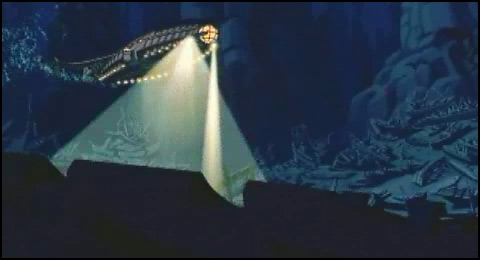
![]() There were never any plans to incorporate songs in Atlantis.
Says Hahn, who previously even made the gargoyles gargle ditties in The
Hunchback of Notre Dame, "We felt our audience screaming at us,
saying, 'You know, it's time for something different.' " Instead they were
replaced with action sequences. "In a musical, the songs are what
catapult the characters forward to the next dramatic level. So does the
action. For the action sequences, we did want it to be scary. When we ask
kids what is the scariest part, they say, 'It's the Leviathan.' When we
ask them what is their favorite part of the movie, they say, 'It's the
Leviathan.' Scary can be really entertaining sometimes. But we also balanced
it with no cussing."
There were never any plans to incorporate songs in Atlantis.
Says Hahn, who previously even made the gargoyles gargle ditties in The
Hunchback of Notre Dame, "We felt our audience screaming at us,
saying, 'You know, it's time for something different.' " Instead they were
replaced with action sequences. "In a musical, the songs are what
catapult the characters forward to the next dramatic level. So does the
action. For the action sequences, we did want it to be scary. When we ask
kids what is the scariest part, they say, 'It's the Leviathan.' When we
ask them what is their favorite part of the movie, they say, 'It's the
Leviathan.' Scary can be really entertaining sometimes. But we also balanced
it with no cussing."
![]() Comments producer
Don Hahn: "The topic of Atlantis has been knocked around the studio
for a while, 8 to 10 years--not unlike Beauty and the Beast which
was there since Walt's days, we just dusted it off."
Comments producer
Don Hahn: "The topic of Atlantis has been knocked around the studio
for a while, 8 to 10 years--not unlike Beauty and the Beast which
was there since Walt's days, we just dusted it off."
![]() In 1996, Disney
regulars Wise, Trousdale, Murphy, and producer Don Hahn were debating their
next project over a pitcher of margaritas. "We wanted adventurers thrown
together by fate, strange underground civilizations, bizarre creatures-and
flying machines," says Wise. "Atlantis seemed like a nice vessel to contain
all that." The friends soon floated a plot: In 1914, a ragtag troop led
by earnest amateur cartographer Milo Thatch fights its way to the legendary
lost land- and finds people instead of a ruin. Fox was their first
choice to voice Milo. "We [envisioned] a kind of Jimmy Stewart, Harold
Lloyd guy," explains Wise. "Michael has such a distinct voice, and a wonderful,
spunky underdog quality." According to the directors, the actor let his
son decide if Dad would work on Atlantis or another otherworldly animated
project, Titan A.E. Boasts Trousdale,
"The 8-year-old saw the coolness of our movie."
In 1996, Disney
regulars Wise, Trousdale, Murphy, and producer Don Hahn were debating their
next project over a pitcher of margaritas. "We wanted adventurers thrown
together by fate, strange underground civilizations, bizarre creatures-and
flying machines," says Wise. "Atlantis seemed like a nice vessel to contain
all that." The friends soon floated a plot: In 1914, a ragtag troop led
by earnest amateur cartographer Milo Thatch fights its way to the legendary
lost land- and finds people instead of a ruin. Fox was their first
choice to voice Milo. "We [envisioned] a kind of Jimmy Stewart, Harold
Lloyd guy," explains Wise. "Michael has such a distinct voice, and a wonderful,
spunky underdog quality." According to the directors, the actor let his
son decide if Dad would work on Atlantis or another otherworldly animated
project, Titan A.E. Boasts Trousdale,
"The 8-year-old saw the coolness of our movie."
![]() "They approached
me because they wanted to do the film in my style", revealed Hellboy creator
Mike Mignola in August 1999. "Whether it's going to happen or not, I don't
know. I did some character designs for the city, for the natives,
except most of it's been Disney-ized. Most of [the story] takes place
in a cave at the bottom of the ocean. [One of the big wigs at Disney]
hated the project because it was a straight action-adventure. No songs.
Guys fight monsters underground. It's sort of a 1914/World War One-looking
expedition to find Atlantis and rape it of its energy source. It's 20,000
Leagues Under The Sea meets Journey To The Center Of The Earth."
A couple of years later, in June 2001, Mike Mignola gave more details on
his experience on this project: "For whatever reason, people in animation
seem to like my work. I think it's because I'm shape-conscious. It's not
fluffy detail-stuff, it's trying to break things down into two or three
simple masses. It was certainly one of the things they were focusing on
at Disney - the simplification of shapes that I do. Quite frankly, I thought
there was one of those times on Atlantis where I was like, well,
this will be one of those projects that never gets done."
"They approached
me because they wanted to do the film in my style", revealed Hellboy creator
Mike Mignola in August 1999. "Whether it's going to happen or not, I don't
know. I did some character designs for the city, for the natives,
except most of it's been Disney-ized. Most of [the story] takes place
in a cave at the bottom of the ocean. [One of the big wigs at Disney]
hated the project because it was a straight action-adventure. No songs.
Guys fight monsters underground. It's sort of a 1914/World War One-looking
expedition to find Atlantis and rape it of its energy source. It's 20,000
Leagues Under The Sea meets Journey To The Center Of The Earth."
A couple of years later, in June 2001, Mike Mignola gave more details on
his experience on this project: "For whatever reason, people in animation
seem to like my work. I think it's because I'm shape-conscious. It's not
fluffy detail-stuff, it's trying to break things down into two or three
simple masses. It was certainly one of the things they were focusing on
at Disney - the simplification of shapes that I do. Quite frankly, I thought
there was one of those times on Atlantis where I was like, well,
this will be one of those projects that never gets done."
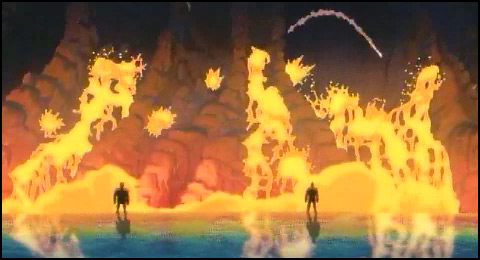
![]() The city layout
is based on Buddist and Hindu architecture. Extensive CG backgrounds were
originally intended, but scaled back (i.e. dropped) when bugetary "austerity"
began in 1998.
The city layout
is based on Buddist and Hindu architecture. Extensive CG backgrounds were
originally intended, but scaled back (i.e. dropped) when bugetary "austerity"
began in 1998.
![]() Based on the strength
of his work for Dinosaur, James Newton
Howard was officially enlisted to compose the score for
Atlantis: The
Lost Empire in June 2000.
Based on the strength
of his work for Dinosaur, James Newton
Howard was officially enlisted to compose the score for
Atlantis: The
Lost Empire in June 2000.
![]() Linguist Marc
Okrand -who created a readable and speakable language for Atlantis:
The Lost Empire- was also a model for the hero, Milo Thatch: "When
I first met animator John Pomeroy, he said, 'I hope it doesn't bother you,
but I'm going to be drawing sketches when I talk to you. You're the only
linguist I've ever met, so I don't know what they look like or how they
behave.'" Marc Okrand, who also created Klingon and Vulcan languages
for Star Trek, sought to make something flowing and soothing for Atlantis.
"It's supposed to be like other languages," said Okrand, who based Atlantean
on Indo-European. "A root language, whatever that is. So I found sounds
that were common." Disney animators drew the 29 letters of the Atlantean
alphabet with Okrand's help. He made a phonetic transcript of the
Atlantean lines in the script, "so I would know what I meant." Yes is "tig,"
no is "kwam," and hello is "supak."
Linguist Marc
Okrand -who created a readable and speakable language for Atlantis:
The Lost Empire- was also a model for the hero, Milo Thatch: "When
I first met animator John Pomeroy, he said, 'I hope it doesn't bother you,
but I'm going to be drawing sketches when I talk to you. You're the only
linguist I've ever met, so I don't know what they look like or how they
behave.'" Marc Okrand, who also created Klingon and Vulcan languages
for Star Trek, sought to make something flowing and soothing for Atlantis.
"It's supposed to be like other languages," said Okrand, who based Atlantean
on Indo-European. "A root language, whatever that is. So I found sounds
that were common." Disney animators drew the 29 letters of the Atlantean
alphabet with Okrand's help. He made a phonetic transcript of the
Atlantean lines in the script, "so I would know what I meant." Yes is "tig,"
no is "kwam," and hello is "supak."
![]() A 60% completed
work-in-progress version of Atlantis was screened for Disney big
wigs Peter Schnider and Tom Schumacher in April 1999. Both Schnider and
Schumacher gave the film a big thumbs up and were so impressed by what
the production team had accomplished they approved three more sequences
to go into production right away for the movie!
A 60% completed
work-in-progress version of Atlantis was screened for Disney big
wigs Peter Schnider and Tom Schumacher in April 1999. Both Schnider and
Schumacher gave the film a big thumbs up and were so impressed by what
the production team had accomplished they approved three more sequences
to go into production right away for the movie!
![]() Supervising animator
John Pomeroy explained in a March 2003 interview that "Milo’s path is very
similar to my own. It is the closest I will probably ever come to animating
myself. On Pocahontas,
the directors wanted live action reference footage for nearly the entire
film. We didn’t have the budget for Atlantis and so I decided to
videotape myself acting out this scene, over and over and over to the vocal
track. Then I took stats that I blew up from the video performance and
I worked my first extremes for the scene off of those stats. I acted out
several versions, and sort of played paper dolls with all these different
version until I had a framework. And then I’d throw away the stats and
work from the extremes and then throw away the first set and work from
the refined animation, and kept going until the movement became instinctual.
It was a happy accident of finding a series of movements that communicate
the nuance of Michael’s vocal performance. The scene comes from a place
of such strength. I used the video as a foundation for understanding movement
and then discarded it so as not to begin to rely on it. I discovered movements
and gestures not at all in the footage, but which only could have been
triggered by understanding the sort of things you can forget about unless
you observe live action very carefully."
Supervising animator
John Pomeroy explained in a March 2003 interview that "Milo’s path is very
similar to my own. It is the closest I will probably ever come to animating
myself. On Pocahontas,
the directors wanted live action reference footage for nearly the entire
film. We didn’t have the budget for Atlantis and so I decided to
videotape myself acting out this scene, over and over and over to the vocal
track. Then I took stats that I blew up from the video performance and
I worked my first extremes for the scene off of those stats. I acted out
several versions, and sort of played paper dolls with all these different
version until I had a framework. And then I’d throw away the stats and
work from the extremes and then throw away the first set and work from
the refined animation, and kept going until the movement became instinctual.
It was a happy accident of finding a series of movements that communicate
the nuance of Michael’s vocal performance. The scene comes from a place
of such strength. I used the video as a foundation for understanding movement
and then discarded it so as not to begin to rely on it. I discovered movements
and gestures not at all in the footage, but which only could have been
triggered by understanding the sort of things you can forget about unless
you observe live action very carefully."
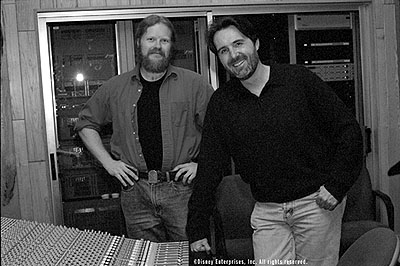
![]() "We started thinking about other movies that we'd grown up with, that were
in the Disney family and that we really liked," director Kirk Wise said.
"We started off on this whole tangent about 20,000 Leagues Under the
Sea and Swiss Family Robinson, this great genre of Disney adventure
films that the studio wasn't really making anymore. The more we talked
about it, the more excited we got about the prospect of trying to do something
like that in animation. It really sounded like fun. In one sense, it was
a departure from stuff we'd worked on before, but in another sense, it
was actually very traditional, reconnecting with the tradition that the
Disney company has. They've got a whole land at Disneyland called Adventureland."
Co-director Gary Trousdale added: "It was a departure for us, having done
musicals, which served the company well for a number of years," co-director
Gary Trousdale added. "As a company, Disney thought we'd just keep doing
that until we're old men. So it was a bit of a challenge for us to sell
this to Michael Eisner. We said, look, you have this land called Adventureland.
Instead of going straight through the castle to Fantasyland, let's take
a left. And here we are in Atlantis."
"We started thinking about other movies that we'd grown up with, that were
in the Disney family and that we really liked," director Kirk Wise said.
"We started off on this whole tangent about 20,000 Leagues Under the
Sea and Swiss Family Robinson, this great genre of Disney adventure
films that the studio wasn't really making anymore. The more we talked
about it, the more excited we got about the prospect of trying to do something
like that in animation. It really sounded like fun. In one sense, it was
a departure from stuff we'd worked on before, but in another sense, it
was actually very traditional, reconnecting with the tradition that the
Disney company has. They've got a whole land at Disneyland called Adventureland."
Co-director Gary Trousdale added: "It was a departure for us, having done
musicals, which served the company well for a number of years," co-director
Gary Trousdale added. "As a company, Disney thought we'd just keep doing
that until we're old men. So it was a bit of a challenge for us to sell
this to Michael Eisner. We said, look, you have this land called Adventureland.
Instead of going straight through the castle to Fantasyland, let's take
a left. And here we are in Atlantis."
![]() Dr. Joshua Sweet
is the first black character in the history of Disney animated feature
films. "It has taken a ridiculously long time," says director Kirk Wise.
Ron Husband, a black animator now in his 26th year at Disney who drew the
Atlantis character, thinks he knows why. Nobody wanted to do it just for
the sake of doing it, he says. "I wouldn't have been as thrilled
if this were something just tacked on," Husband says. "We're in the storytelling
business. We're not trying to make a point." In this case, Wise imagined
Preston B. Whitmore, the eccentric billionaire who finances the 1914 expedition
to Atlantis, to be a forward thinker in every way. "His technology is 100
years in the future and his social thinking is, too. He would assemble
the best crew he could with no regard to sex, race or age."
Phil Morris, best known as the motormouth Johnnie Cochran sendup, Jackie
Chiles on Seinfeld, supplies the voice of Sweet. "My memory banks
are filled with Disneyana, but I was not really aware that the character
was breaking the door in," Morris says. "But Ron kept saying stuff to me
like, 'I'm very happy to be working with you' and 'You're bringing so much
to this.' I believe I finally asked him, 'Is this unique? Is the first
time?' He said yes. He was so proud of the character." Husband and
Morris were determined to avoid the obvious pitfalls. "He and I were very
mindful of not making this character the comic relief," Morris says. "Dr.
Sweet has a lot of dimension and a lot of humanity. He is the doctor and
a man of science and medicine."
Dr. Joshua Sweet
is the first black character in the history of Disney animated feature
films. "It has taken a ridiculously long time," says director Kirk Wise.
Ron Husband, a black animator now in his 26th year at Disney who drew the
Atlantis character, thinks he knows why. Nobody wanted to do it just for
the sake of doing it, he says. "I wouldn't have been as thrilled
if this were something just tacked on," Husband says. "We're in the storytelling
business. We're not trying to make a point." In this case, Wise imagined
Preston B. Whitmore, the eccentric billionaire who finances the 1914 expedition
to Atlantis, to be a forward thinker in every way. "His technology is 100
years in the future and his social thinking is, too. He would assemble
the best crew he could with no regard to sex, race or age."
Phil Morris, best known as the motormouth Johnnie Cochran sendup, Jackie
Chiles on Seinfeld, supplies the voice of Sweet. "My memory banks
are filled with Disneyana, but I was not really aware that the character
was breaking the door in," Morris says. "But Ron kept saying stuff to me
like, 'I'm very happy to be working with you' and 'You're bringing so much
to this.' I believe I finally asked him, 'Is this unique? Is the first
time?' He said yes. He was so proud of the character." Husband and
Morris were determined to avoid the obvious pitfalls. "He and I were very
mindful of not making this character the comic relief," Morris says. "Dr.
Sweet has a lot of dimension and a lot of humanity. He is the doctor and
a man of science and medicine."
 |
 |
![]() "This is my second
fantasy language," says Cree Summer, the voice of Princess Kida. "I also
speak Ewokian." Summer voiced Princess Kneesaa in the TV series Ewoks in
the 1980s. "I'd drive around in my car going bonkers," she says of
listening to Okrand's tapes of Atlantean. "I mean, this is not an easy
language to get." Yet Atlantean was almost easier to learn, she says,
than speaking English with an accent as Kida, "because that is another
thing we had to invent and fool around with and still make her easy to
understand. But that was a cool thing. I felt like I got to contribute
a little bit of my creativity."
"This is my second
fantasy language," says Cree Summer, the voice of Princess Kida. "I also
speak Ewokian." Summer voiced Princess Kneesaa in the TV series Ewoks in
the 1980s. "I'd drive around in my car going bonkers," she says of
listening to Okrand's tapes of Atlantean. "I mean, this is not an easy
language to get." Yet Atlantean was almost easier to learn, she says,
than speaking English with an accent as Kida, "because that is another
thing we had to invent and fool around with and still make her easy to
understand. But that was a cool thing. I felt like I got to contribute
a little bit of my creativity."
![]() Atlantis
had its public debut eleven months prior to its projected June 2001 release
with a gala panel at the 2000 San Diego Comic-Con and the earliest website
launch in memory for a Disney feature cartoon. This was supposedly
meant to overshadow The Emperor's
New Groove: released only 6 months before Atlantis, it was
rumored to be an embarassment for the studio and a project hated by its
head Michael Eisner; The Emperor's website was launched at the same
time as Atlantis and had practically no licensees recruited.
Atlantis
had its public debut eleven months prior to its projected June 2001 release
with a gala panel at the 2000 San Diego Comic-Con and the earliest website
launch in memory for a Disney feature cartoon. This was supposedly
meant to overshadow The Emperor's
New Groove: released only 6 months before Atlantis, it was
rumored to be an embarassment for the studio and a project hated by its
head Michael Eisner; The Emperor's website was launched at the same
time as Atlantis and had practically no licensees recruited.
![]() The
original opening involved Vikings off the coast of Iceland finding a journal
that is later used to find Atlantis. The directors decided late into
the production to drop that scene and try instead a new opening that could
introduce us to Atlantis.
The
original opening involved Vikings off the coast of Iceland finding a journal
that is later used to find Atlantis. The directors decided late into
the production to drop that scene and try instead a new opening that could
introduce us to Atlantis.
![]() Disney allegedly
cut the budget on the film multiple times and got rid of some epic moments.
The final movie has supposedly been testing very wishy-washy with test
audiences as well as with the Disney animators themselves, who think it's
too "New Agey" and don't have high hopes for it.
Disney allegedly
cut the budget on the film multiple times and got rid of some epic moments.
The final movie has supposedly been testing very wishy-washy with test
audiences as well as with the Disney animators themselves, who think it's
too "New Agey" and don't have high hopes for it.
![]() The Orlando Weekly
further explained, in January 2002, that "in the wake of disappointing
ticket sales for Walt Disney Pictures' 2000 release Dinosaur
(not to mention its $135 million price tag), Mouse House managers ordered
that all animated films in production undergo severe financial scrutiny.
As a result, projects that seemed to have limited commercial appeal, such
as a computer-animated version of "Pygmalion," tentatively titled Wild
Life, were cancelled outright. Other still-in-production WDFA films
received "reductions in scope." When they reviewed the storyboards for
Atlantis,
they quickly selected two sequences for the cutting-room floor: a scene
in which the intrepid explorers battled several subterranean monsters,
as well as one in which Milo and friends were trapped in a cave and buffeted
by mysterious hurricane-force winds. Directors Kirk Wise and Gary Trousdale
fought mightily to save those scenes. They argued that their removal unintentionally
would gut the middle act of their movie, reducing the drama of the arduous
journey to find a lost civilization miles below the earth's surface. Given
their track record (Wise and Trousdale had delivered two of Disney's bigger
animated films of the last decade, 1991's Beauty
and the Beast and 1996's The
Hunchback of Notre Dame), you might think the Mouse would let them
make their movie the way they wanted to make it. Instead, the studio brass
insisted on the cuts, threatening to take the project away from them or
shut down production entirely if they resisted. There's no word yet as
to whether Wise and Trousdale are planning to join Goldberg, Bancroft and
the Brizzis in the exodus from Walt Disney Feature Animation. But, if the
Mouse continues to treat its top talent like this, Atlantis may not be
the only empire that Disney loses."
The Orlando Weekly
further explained, in January 2002, that "in the wake of disappointing
ticket sales for Walt Disney Pictures' 2000 release Dinosaur
(not to mention its $135 million price tag), Mouse House managers ordered
that all animated films in production undergo severe financial scrutiny.
As a result, projects that seemed to have limited commercial appeal, such
as a computer-animated version of "Pygmalion," tentatively titled Wild
Life, were cancelled outright. Other still-in-production WDFA films
received "reductions in scope." When they reviewed the storyboards for
Atlantis,
they quickly selected two sequences for the cutting-room floor: a scene
in which the intrepid explorers battled several subterranean monsters,
as well as one in which Milo and friends were trapped in a cave and buffeted
by mysterious hurricane-force winds. Directors Kirk Wise and Gary Trousdale
fought mightily to save those scenes. They argued that their removal unintentionally
would gut the middle act of their movie, reducing the drama of the arduous
journey to find a lost civilization miles below the earth's surface. Given
their track record (Wise and Trousdale had delivered two of Disney's bigger
animated films of the last decade, 1991's Beauty
and the Beast and 1996's The
Hunchback of Notre Dame), you might think the Mouse would let them
make their movie the way they wanted to make it. Instead, the studio brass
insisted on the cuts, threatening to take the project away from them or
shut down production entirely if they resisted. There's no word yet as
to whether Wise and Trousdale are planning to join Goldberg, Bancroft and
the Brizzis in the exodus from Walt Disney Feature Animation. But, if the
Mouse continues to treat its top talent like this, Atlantis may not be
the only empire that Disney loses."
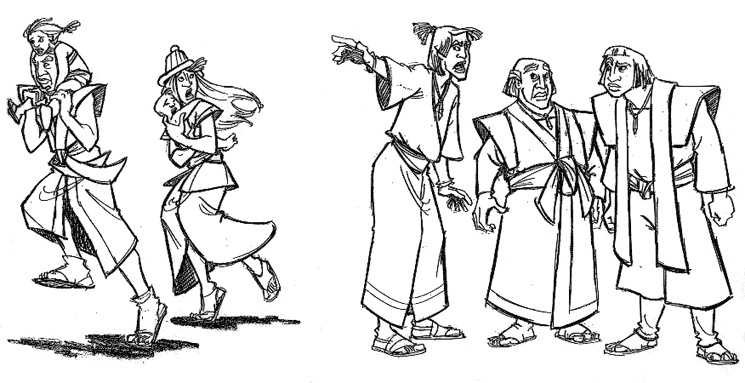
![]() Thomas Schumacher, president of Disney feature animation, denied that Disney
was jumping on a bandwagon: "In animation you can't follow fad or fashion
because they are four to five years in production... My confidence is pretty
good."
Thomas Schumacher, president of Disney feature animation, denied that Disney
was jumping on a bandwagon: "In animation you can't follow fad or fashion
because they are four to five years in production... My confidence is pretty
good."
![]()
![]() Disney
Interactive gave away 12 million copies of a 3D online multiplayer game
in April 2001, as an introduction to its Atlantis: The Lost Empire.
This promotion marked the largest free distribution of an interactive game
to date. In addition to serving as an introduction to the film -Atlantis:
The Lost Empire: Search for the Journal takes place 13 years before the
beginning of the film-, the game served as an introduction to the retail
PC game, Atlantis: The Lost Empire: Trial by Fire.
Disney
Interactive gave away 12 million copies of a 3D online multiplayer game
in April 2001, as an introduction to its Atlantis: The Lost Empire.
This promotion marked the largest free distribution of an interactive game
to date. In addition to serving as an introduction to the film -Atlantis:
The Lost Empire: Search for the Journal takes place 13 years before the
beginning of the film-, the game served as an introduction to the retail
PC game, Atlantis: The Lost Empire: Trial by Fire.
![]()
![]() Disney
had several "Atlantis" inspired projects in the pipeline--including the
Fire
Mountain transforming roller coaster for WDW's Magic Kingdom and
the "Atlantis Expedition" redo of Disneyland's Submarine ride--, which
were cancelled following Atlantis' disappointing box office results.
Disney
had several "Atlantis" inspired projects in the pipeline--including the
Fire
Mountain transforming roller coaster for WDW's Magic Kingdom and
the "Atlantis Expedition" redo of Disneyland's Submarine ride--, which
were cancelled following Atlantis' disappointing box office results.

![]() Producer Don Hahn revealed
in May 2001 that Atlantis' DVD would feature the alternative opening,
a cut scene where a group of Vikings, using the book seen in the trailer,
are searching for the Lost Empire; they are suddenly attacked by the massive
Leviathan and their ships are sunk. Hahn is very proud of the fact that
they are actually speaking ancient Norse in the scene. This scene was cut
from the film during editing since it broke up the pace of the film and
didn't fit. Says Don: "I would hope that there will be a sequel;
if it connects with an audience, it could become a franchise -people could
experience it as a game... We would love to do a sequel!"
Producer Don Hahn revealed
in May 2001 that Atlantis' DVD would feature the alternative opening,
a cut scene where a group of Vikings, using the book seen in the trailer,
are searching for the Lost Empire; they are suddenly attacked by the massive
Leviathan and their ships are sunk. Hahn is very proud of the fact that
they are actually speaking ancient Norse in the scene. This scene was cut
from the film during editing since it broke up the pace of the film and
didn't fit. Says Don: "I would hope that there will be a sequel;
if it connects with an audience, it could become a franchise -people could
experience it as a game... We would love to do a sequel!"
![]() The
$82 million box office gross on Atlantis is the lowest for any Disney
toon since The Rescuers Down Under
in 1990.
The
$82 million box office gross on Atlantis is the lowest for any Disney
toon since The Rescuers Down Under
in 1990.
![]() Voice
actor Corey Burton, who supplied the voice of Mole, commented in a February
2002 interview: "I absolutely loved every aspect of working on Atlantis.
Fantastic, brilliant, wonderful people made it all a genuine Dream Come
True."
Voice
actor Corey Burton, who supplied the voice of Mole, commented in a February
2002 interview: "I absolutely loved every aspect of working on Atlantis.
Fantastic, brilliant, wonderful people made it all a genuine Dream Come
True."
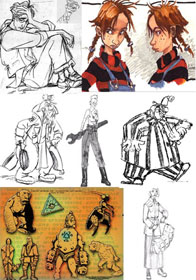 The
short version? "Back when co-directors Kirk Wise & Gary
Trousdale and producer Don Hahn initially conceived this project," explains
Jim
Hill Media, "they wanted
Atlantis: The Lost Empire to be the
ultimate Ray Harryhausen movie. A film where--every few minutes--the crew
of the 'Ulysses' would have yet another encounter with another fearsome
creature. One of their more intriguing ideas for this project was that
there would be a monster in the movie that was tied to each one of the
four primal elements: earth, water, fire & air. The water beast, you
already know about: The Leviathan, the giant mechanical lobster-thingy
that destroyed the giant sub. But--had Wise, Trousdale & Hahn actually
stuck with this intriguing notion--the 'Ulysses' would have survived its
eventful encounter with the Leviathan… Only to have the sub be accidentally
destroyed as a result of a battle that Captain Rourke and his crew had
with some beasts from the air. And what sort of monsters were these? A
vicious swarm of Squid Bats (horrible slimy flying creatures that would
swoop down and grab up their victims in their tentacles). Over the next
20 minutes or so in the movie, the surviving members of the sub's crew
would have encountered even more harrowing beasts as they journeyed deeper
into the bowels of the earth. For example: What they think is a land bridge
across a boiling pool of magma turns out to be a Lava Whale (an enormous
earth-based beast that suddenly rises up out of the lava and attacks the
ill-fated adventurers, killing a fourth of the surviving crew members in
the course of the battle). And then there were the Fire Flies that set
most of the expedition’s remaining equipment ablaze. (That sequence did
actually manage to make it into the finished version of Atlantis:
The Lost Empire without being too severely cut). Milo was also originally
supposed to encounter Kida when he accidentally got in the way of an Atlantean
hunting party that was pursuing a caterpillar that was the size of a school
bus.
The
short version? "Back when co-directors Kirk Wise & Gary
Trousdale and producer Don Hahn initially conceived this project," explains
Jim
Hill Media, "they wanted
Atlantis: The Lost Empire to be the
ultimate Ray Harryhausen movie. A film where--every few minutes--the crew
of the 'Ulysses' would have yet another encounter with another fearsome
creature. One of their more intriguing ideas for this project was that
there would be a monster in the movie that was tied to each one of the
four primal elements: earth, water, fire & air. The water beast, you
already know about: The Leviathan, the giant mechanical lobster-thingy
that destroyed the giant sub. But--had Wise, Trousdale & Hahn actually
stuck with this intriguing notion--the 'Ulysses' would have survived its
eventful encounter with the Leviathan… Only to have the sub be accidentally
destroyed as a result of a battle that Captain Rourke and his crew had
with some beasts from the air. And what sort of monsters were these? A
vicious swarm of Squid Bats (horrible slimy flying creatures that would
swoop down and grab up their victims in their tentacles). Over the next
20 minutes or so in the movie, the surviving members of the sub's crew
would have encountered even more harrowing beasts as they journeyed deeper
into the bowels of the earth. For example: What they think is a land bridge
across a boiling pool of magma turns out to be a Lava Whale (an enormous
earth-based beast that suddenly rises up out of the lava and attacks the
ill-fated adventurers, killing a fourth of the surviving crew members in
the course of the battle). And then there were the Fire Flies that set
most of the expedition’s remaining equipment ablaze. (That sequence did
actually manage to make it into the finished version of Atlantis:
The Lost Empire without being too severely cut). Milo was also originally
supposed to encounter Kida when he accidentally got in the way of an Atlantean
hunting party that was pursuing a caterpillar that was the size of a school
bus.
So why did Kirk, Gary and Don eventually decide not to go forward with the ultimate Ray Harryhausen film that they had originally envisioned? There are three reasons. One is that the Squid Bat & Lava Whale battle scenes would have been prohibitively expensive to animate. And given that Atlantis was one of the films that WDFA actually had in production while Hercules and Dinosaur were out in theaters, failing to meet their box office projections, it also becames one of the very first Disney Feature projects to undergo a 'reduction in scope.' Secondly, early test screenings of Atlantis: The Lost Empire revealed that audience members were actually pretty anxious to finally get to see the fabled underground city. So anything that slowed Milo & the other adventurers down seemed to lessen these folks' enjoyment of the movie. So to help speed the story along, five monster scenes ended up being reduced to two. And the third reason that Wise, Trousdale and Hahn eventually decided to cut back on Atlantis' monsters was perhaps the most controversial: early test screenings of the movie revealed that audiences thought that the film lacked heart. So the original prologue, where a bunch of fortune seeking Vikings lost their lives at the claws of the Leviathan, was replaced with a sequence that actually showed the destruction of Atlantis and set up Kida's emotional arc." Leica reel versions of the film's proposed Squid Bat and Lava Whale sequences are fortunately available on the Special edition of the Atlantis: The Lost Empire DVD.
The longer, official version? The idea of an animated movie about the fabled lost city civilization of Atlantis has been kicking around the Disney cartoon arena for a decade. Nothing much was done until a bunch of the boys got together at a Mexican restaurant near the studios in Burbank and kickstarted the idea into action.
 When
it came time to sell the idea to Michael Eisner, Disney's head honcho,
and to Roy E. Disney, Walt's nephew and the animation department's independent
guru, producer Don Hahn put it over in unique fashion by using a few Disneyland
attractions as references. According to Hahn now, this was his "boneheaded"
pitch: "We've been to Fantasyland a lot. We've done a lot of fairytale
musicals and been through the castle at the end of Main Street a few times.
Let's go down to the end of Main Street and turn left, because there's
this whole place there called Adventureland. Let's make an Adventureland
movie!"
When
it came time to sell the idea to Michael Eisner, Disney's head honcho,
and to Roy E. Disney, Walt's nephew and the animation department's independent
guru, producer Don Hahn put it over in unique fashion by using a few Disneyland
attractions as references. According to Hahn now, this was his "boneheaded"
pitch: "We've been to Fantasyland a lot. We've done a lot of fairytale
musicals and been through the castle at the end of Main Street a few times.
Let's go down to the end of Main Street and turn left, because there's
this whole place there called Adventureland. Let's make an Adventureland
movie!"
Diving into uncharted realms of art and the imagination, Walt Disney Pictures and the filmmaking trio responsible for the recent animated favorite Beauty and the Beast - producer Don Hahn and directors Gary Trousdale and Kirk Wise - take moviegoers on a wondrous animated expedition to "Atlantis: The Lost Empire." With its bold, graphic visual interpretation and eye-popping wide-screen animation, "Atlantis" is an exciting and imaginative cinematic journey to a fascinating and mysterious place. Expressive character animation, the Studio's most ambitious blend of digital and hand-drawn special effects and an action-oriented story add to the film's extraordinary appeal. With a vocal cast headed by Michael J. Fox, James Garner and Leonard Nimoy, innovative sound effects by seven-time Academy Award®-winning designer/mixer Gary Rydstrom, and a stunning underscore by acclaimed composer James Newton Howard, the film's sound is as impressive as its look and delivers the right tone of comedy, action and drama.
In Atlantis: The Lost Empire, an inexperienced young adventurer becomes the key to unraveling an ancient mystery when he joins a group of daredevil explorers to find the legendary lost empire. At the center of this action-filled animated adventure is naïve-but-determined museum cartographer / linguistics expert Milo Thatch, who dreams of completing the quest begun by his late grandfather, a famous explorer. When a long lost journal surfaces, providing new clues to the location, and an eccentric billionaire agrees to fund an expedition, the action shifts into high gear. Milo ultimately leads Commander Rourke and his team to the elusive undersea kingdom but what they find there defies their expectations and triggers an explosive series of events that only Milo can resolve.
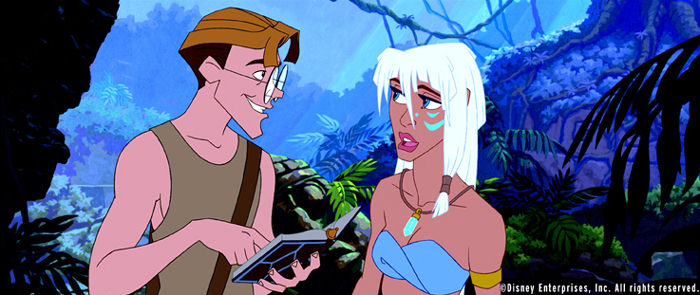 A
wonderful group of actors and actresses were enlisted to give voice to
the characters. Michael J. Fox's bold vocalization of Milo Thatch gives
the character the energy, strength, and appeal of an action hero. Veteran
actor James Garner lends his genial, avuncular style to the character of
Commander Rourke. Leonard Nimoy gives a royal turn as the reclusive King
of Atlantis, who alone holds the secrets of his civilization. Providing
the vocals for his daring daughter, Princess Kida, is veteran voiceover
actress Cree Summer. John Mahoney is heard as the eccentric billionaire,
Preston B. Whitmore, who finances the expedition to Atlantis. David Ogden
Stiers, a Disney animation favorite, returns to the Studio to voice Milo's
bombastic boss, Fenton Q. Harcourt.
A
wonderful group of actors and actresses were enlisted to give voice to
the characters. Michael J. Fox's bold vocalization of Milo Thatch gives
the character the energy, strength, and appeal of an action hero. Veteran
actor James Garner lends his genial, avuncular style to the character of
Commander Rourke. Leonard Nimoy gives a royal turn as the reclusive King
of Atlantis, who alone holds the secrets of his civilization. Providing
the vocals for his daring daughter, Princess Kida, is veteran voiceover
actress Cree Summer. John Mahoney is heard as the eccentric billionaire,
Preston B. Whitmore, who finances the expedition to Atlantis. David Ogden
Stiers, a Disney animation favorite, returns to the Studio to voice Milo's
bombastic boss, Fenton Q. Harcourt.
"I play the Director of the Institute," grins Stiers, "he's not a particularly open minded man and a bit of a snob about what he does, as people in large institutions have tended to be. We play the stereotype rather than the contemporary model. Stuffy, vicious and grudge carrying."
Mr. Stiers enjoyed his work on the animation. His typical work day was "…actually very fast. They tend to limit sessions to about three hours because, after three hours, I can't hear any difference in what I'm doing. It just isn't productive to go beyond that point. They're very good to me. I tend to work very fast so we get the work done that's slated for the day."
What's it like day by day for an actor to work on an animation? Mr. Stiers elaborates, "In a weird way, it's freeing because there's nobody looking at you. You don't care how you look when you produce a voice. It's very limited because you don't have the present energy of another actor, even if it's someone you don't particularly agree with. There is still some solution you find [when working alone] since you don't have that wonderfully creative energy or vibration another actor has to offer. Still, actors find wonderful vocal solutions without confronting one another."
From the very inception of the project, the directors had a strong concept of what the film should look like. Mutual fans of a popular comic book artist named Mike Mignola (Hellboy, "Bram Stoker's Dracula" - the official comic adaptation of Francis Ford Coppola's Film, etc.), Trousdale and Wise chose a bold departure for the design and style of "Atlantis." Enlisting the talents of art director Dave Goetz (their collaborator on The Hunchback of Notre Dame), the directors brought in Mignola to help design the production and to freely adapt his flat, graphic and layered style for their purposes. The resulting blend of classic Disney and Mike Mignola - a style which was internally referred to as "Dis-nola" - gave the film a daring and expressive look unlike any of the Studio's other features. Mignola himself had a hand in designing Atlantis and gave it a distressed tropical paradise look with a Southeast Asian flavor. His design style is felt throughout the film in the look of the characters and the background settings. In keeping with the film's 1914 setting, the artistic team incorporated elements of the machine age/industrial period with the imaginative graphic style of Mignola.
 Helping
to achieve this distinctive look for the film was an artistic team that
includes background supervisor Lisa Keene, layout supervisor Ed Ghertner
and artistic coordinator Chris Jenkins. The film's other artistic leaders
are computer graphics imagery supervisor Kiran Bhakta Joshi, visual effects
supervisor Marlon West, cleanup supervisor Marshall Toomey, scene planning
supervisor Tom Baker and color models supervisor Karen Comella. Ellen Keneshea
is the film's editor. Another key player on the production team is associate
producer Kendra Haaland.
Helping
to achieve this distinctive look for the film was an artistic team that
includes background supervisor Lisa Keene, layout supervisor Ed Ghertner
and artistic coordinator Chris Jenkins. The film's other artistic leaders
are computer graphics imagery supervisor Kiran Bhakta Joshi, visual effects
supervisor Marlon West, cleanup supervisor Marshall Toomey, scene planning
supervisor Tom Baker and color models supervisor Karen Comella. Ellen Keneshea
is the film's editor. Another key player on the production team is associate
producer Kendra Haaland.
In order to do justice to the film's vast landscape and lavish settings, the filmmakers chose to present "Atlantis" in CinemaScope. This wide-screen format has only been used in animation on rare occasions (Lady and the Tramp, Sleeping Beauty, and A Bug's Life) and the impact is extraordinary. A wide-screen presentation requires a special approach to composition plus additional animation to utilize the larger screen area. Hahn notes, "The CinemaScope screen is 30% bigger than a regular movie screen and it delivers a visceral moviegoing experience that transports audiences. Action/adventure films are ideally suited to the wide screen and 'Atlantis' uses this expanded canvas to maximum advantage."
Adding a whole other level of credibility to the Atlantean civilization,
the filmmakers turned to real-life linguistics expert Marc Okrand to create
an original readable, speakable language. Okrand, who had previously created
words for the Vulcan language (for "Star Trek II") and went on to invent
the Klingon language (used in "Star Trek III" and on "Star Trek: The Next
Generation"), made up hundreds of Atlantean words for this film that are
spoken by Michael J. Fox, Leonard Nimoy, Cree Summer and others. The Atlantean
language, which has a corresponding 29 letter alphabet, is rooted in Indo-European
but
essentially has a set of rules all its own.
 In
keeping with its reputation as an action-adventure film, "Atlantis: The
Lost Empire" represents the biggest animated effects film the Studio has
ever done and the best integration of traditional 2D and digital 3D effects
in Disney's history. Artistic
In
keeping with its reputation as an action-adventure film, "Atlantis: The
Lost Empire" represents the biggest animated effects film the Studio has
ever done and the best integration of traditional 2D and digital 3D effects
in Disney's history. Artistic
coordinator Chris Jenkins estimates that there is some form of effects
in 6000 of the 7600 feet of film. Digital effects (362 in all) are seen
in 30% of the film and "Deep Canvas" (a digital approach to painting backgrounds
which was created for Tarzan to add a
sense of depth to the scene) was used in at least half a dozen scenes.
Among the dynamic visual effects seen in "Atlantis" are explosions, lava-spouting
volcanoes, fire-setting fireflies, glowing crystals, laser beams, atmospheric
effects, tidal waves, bubbles, and crowd scenes, among others.
Adding to its impact as an action-adventure film is a dynamic score by James Newton Howard. Director Kirk Wise notes, "He gives the film such scale and sweep and really huge emotion. He doesn't remove a portion of his brain and write 'cartoon' music, which is a trap that some composers can fall into when they write for this genre. He treats the film as he would a live-action film and his contribution is truly amazing."
Animation on "Atlantis: The Lost Empire" began in late 1997 with the production team eventually reaching a maximum of about 350 artists, animators and technicians. Although most of the production took place in California, Disney's Paris Animation Studio also made a major contribution to the effort with the animation of Helga Sinclair and some of the film's backgrounds, cleanup animation and digital effects.
The filmmakers assembled a top team of animators to bring their large
ensemble cast of characters to life. Many of the supervising animators
(including John Pomeroy, Ron Husband, Dave Pruiksma, Tony DeRosa, Mike
Cedeno and Shawn Keller) have been associated with Disney Feature Animation
for two decades. Several have supervised characters before
(Mike Surrey, Russ Edmunds and Randy Haycock), while others (including
Anne Marie Bardwell and Yoshi Tamura) stepped up to the plate with first-time
supervising roles on this film.
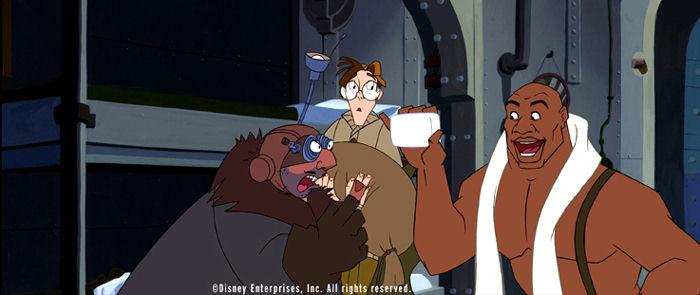 "We
had a great group of people working on this film," notes Hahn. "There was
a lot of experience in the ranks, from Gary and Kirk on down, and this
was a team which had largely worked together before on 'Beauty'
and 'The Hunchback of Notre Dame.'
They communicated well and they had a lot of fun in the process. We had
a lot of depth on our bench in terms of creative talent and we discovered
some really great new talent as well."
"We
had a great group of people working on this film," notes Hahn. "There was
a lot of experience in the ranks, from Gary and Kirk on down, and this
was a team which had largely worked together before on 'Beauty'
and 'The Hunchback of Notre Dame.'
They communicated well and they had a lot of fun in the process. We had
a lot of depth on our bench in terms of creative talent and we discovered
some really great new talent as well."
Thomas Schumacher, president of Walt Disney Feature Animation, observes, "'Atlantis' presented our creative team with a great opportunity to explore the action-adventure genre in animation and Don, Kirk and Gary have taken full advantage of the medium to tell a great story. They are masters at what they do and this film reflects a new level of maturity and storytelling excellence for them as filmmakers. The film itself has a look and style all its own with a great ensemble of characters that we think audiences are going to love. Everyone seems to have a different theory about Atlantis and it was fun for us to learn about some of those exciting notions and come up with our own mythological take on this fascination subject."
"Because we've done so many (movies with) fuzzy sidekicks and people
breaking into songs, this is a big departure," producer Don Hahn says.
"So that represents a certain amount of risk and trepidation. Animation
itself is not a genre. It's a medium where you can do a lot of different
genres. So the first question is, 'Why animate that?' And it's a
valid point these days. Ten years ago, you could have argued that animation
does these things well -- creatures, special effects -- and live action
doesn't. Now, all those lines are grey and kind of blurred because,
arguably, The Mummy Returns is an animated movie. In the end, you
have to come back to storyline and character and come back to a level of
fantasy in our movies that we think is interesting."
INTERVIEW WITH PRODUCER DON HAHN
Interview by Smilin`
Jack Ruby, from March 23, 2001.
Q: Just to start with, can you give us a set up? What is Atlantis: The Lost Empire?
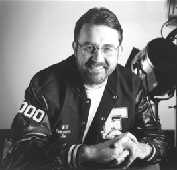 Don
Hahn: Oh, boy. Big, fun, action-adventure movie, you know, in the style
of Raiders of the Lost Ark or those great old Disney movies of the
50’s like 20,000 Leagues and just a great opportunity to expand
the medium of animation and try to take it to a place we’ve never been
before, especially a place like Atlantis because everybody knows the title
"Atlantis," but nobody really knows the mythology or what that all means.
So, it’s been a great process bringing Atlantis to the big screen.
Don
Hahn: Oh, boy. Big, fun, action-adventure movie, you know, in the style
of Raiders of the Lost Ark or those great old Disney movies of the
50’s like 20,000 Leagues and just a great opportunity to expand
the medium of animation and try to take it to a place we’ve never been
before, especially a place like Atlantis because everybody knows the title
"Atlantis," but nobody really knows the mythology or what that all means.
So, it’s been a great process bringing Atlantis to the big screen.
Q: How much of the mythology did you bring out of history and how much of it did you come up with on your own?
Don: Well, a lot of it came from history. I think we started on the internet with a couple of months of research, picking out things that go back as far as Plato to Solon, the kind of politician/statesman who told Plato stories of Atlantis to more modern day people like Edgar Cayce or Ignatius Donnelly, the U.S. Senator who wrote about Atlantis back in the 1800’s. We kind of tried to do our homework and study about the Atlantis mythology, but then spin our own sort of story based on original elements that related to that mythology, but was a fresh story for us.
Q: Why Atlantis? You’ve done stories in the past that are branded to where people know what they are before they hit the theaters. What about Atlantis seemed topical and timely for you to do a movie about it?
Don: In a world that’s, here in California, struggling with power outages, you know, things like relationships and energy crises and political turmoil, Atlantis was to have been a culture that was perfect at one time and I think we’re all fascinated with what that would be. What would be a place to live in that was utopian, that was perfect, an ideal. I think that’s why it’s incredibly topical, because I think it’s fascinating to all of us in our kind of times we live in. What would it be like? Of course, in our story we paint an Atlantis that was perfect except for one fatal flaw. In our story, we talk about their fascination with their technology, the kind of "heart of Atlantis," the crystals of Atlantis and how that was their undoing. So, it’s topical just in people’s fascination with Atlantis in general as a utopian civilization becomes fascinating in and of itself.
Q: Is there a particular civilization or mythos that you based the artistry or architecture of Atlantis on?
Don: Well, no, because I suppose in our reading and certainly what the directors and I wanted to do with the movie was create an Atlantis that was a mother civilization both in terms of its language and its architecture. We wanted to create a civilization that really felt like it was the wellspring of all other civilizations and that’s how it’s described in a lot of mythology. So, we went around for architecture, for example, and looked at Cambodian ruins and Tibetan, Balinese, Nepalese, Indian architecture and tried to mould that all together into one common language where you could believe Atlantis was a mother civilization because you can see elements of other civilizations in the architecture on the screen. The same is true of the language we created for the screen. Mark Okrand who did the Klingon language for Star Trek came in and helped us develop a spoken dialect for the Atlanteans that was the same thing, kind of a primitive dialect that you could imagine was like the dialects people spoke before the Tower of Babel – a "root" dialect. I think that was kind of fascinating trying to recreate those core traits of what a civilization might have been.
Q: Does that mean the lettering you’re using is some kind of early transliteration of any kind of Greek lettering or where did that come from?
Don: We made it up (laughs). We looked at a lot of early typefaces, Phoenician, Greek, a lot of different cultures even Asian typefaces and then just tried to come up with something you couldn’t quite put your finger on. It wasn’t Arabic, it wasn’t Chinese, it wasn’t Phoenician or Sanskrit or something, it was just something that was uniquely "Atlantean," but again was reminiscent of all of those cultures.
 Q:
Over the past ten years, how have things changed about the way you balance
playing to both adults and kids?
Q:
Over the past ten years, how have things changed about the way you balance
playing to both adults and kids?
Don: Well, you know it’s always been – we make movies for family audiences and we really take that literally. We make them for the entire family. I think the minute we try to focus in on any segment of that family, we’ll lose our audience. I think even going back to films like Aladdin and Lion King and films that had several levels to them, I think what has not changed is that we try to create a film that has several levels to it where the kids can appreciate it on one level for its physical humor and comedy and the adults can appreciate it on other levels for its subtext or its metaphor. I think that’s what makes it interesting. We don’t want to make movies where Moms and Dads just drop their kids off at the theater. I think Atlantis, in particular, is incredibly compelling for adults to look at because of the conclusions it draws or the conversations you can have in the car on the way home from the theater. I think, because of that, it’s an interesting topic. Essentially, our approach to filmmaking hasn’t changed all that much.
Q: I was at the WGA theater last night where Jeffrey Katzenberg introduced Shrek and he talked a lot about how much animation had changed since the days of Little Mermaid and Lion King. How do you regard some of the new abilities granted to animators through computers and how much of that did you incorporate into Atlantis versus something like The Emperor’s New Groove or Hunchback?
Don: Atlantis is a real hybrid movie. It’s got loads of digital animation, probably some computer graphics elements in virtually every scene and yet, a lot of the film was created with traditional methods. It’s one of those movies that’s really at a crossroads for us. Half of our crew came in and picked up a pencil, half came in and picked up a mouse and created with a keypad and a digitizing tablet. I think that was what was exciting about the film is that we weren’t driven by the need to make a all computer graphics film or an all traditional film. I think that’s what you’ll find more and more is, right now, we look at them as two different mediums, there’s CG films like Toy Story or Shrek and there’s traditional films like The Emperor’s New Groove and I think those lines are going to become very gray over the next several years as artists just pick up whatever pencil they need to make the movie.
Q: How is that decision made? What things are so intensive that they are done in CG and what things are chosen to be done traditionally?
Don: On Atlantis, we had a whole civilization of vehicles and creatures and just cool stuff to create. To create something on the screen that’s unique for our audience, some of the creatures and elements of the movie would be too intense to draw by hand, so we just turned to the computer to help us create those creatures or those set pieces in the movie. So, it’s really a creative decision driven by the story-telling and the directors and how we approach what technique we use to approach that part of the movie.
Q: There seems to be a real Jules Verne influence...
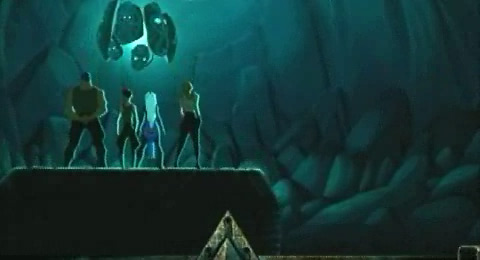 Don:
It’s probably a little later than Jules Verne because that was more Victorian,
more ornamented, more Captain Nemo, so we tried to go a little later in
time period to 1914 which was on the crest of the first world war and that
was the time that we really felt like man was at a crossroads. There were
a lot of people living on farms and plowing the land every day, but there
was also a tremendous industrial nation going on and it was a real crossroads
where exploration and invention and the new modern era was coming into
its own. We thought it was a really interesting point of departure for
the film, but also an interesting contrast visually to what Atlantis is.
In our film, Atlantis is a very ancient culture, very organic and tribal
in its look and that was an interesting kind of contrast to the sheet-metal-and-rivets
surface world in our film.
Don:
It’s probably a little later than Jules Verne because that was more Victorian,
more ornamented, more Captain Nemo, so we tried to go a little later in
time period to 1914 which was on the crest of the first world war and that
was the time that we really felt like man was at a crossroads. There were
a lot of people living on farms and plowing the land every day, but there
was also a tremendous industrial nation going on and it was a real crossroads
where exploration and invention and the new modern era was coming into
its own. We thought it was a really interesting point of departure for
the film, but also an interesting contrast visually to what Atlantis is.
In our film, Atlantis is a very ancient culture, very organic and tribal
in its look and that was an interesting kind of contrast to the sheet-metal-and-rivets
surface world in our film.
Q: What can you tell me about the character designs of the Atlanteans and how they’re different from the humans in the picture?
Don: We pulled on a lot of different inspirations. Mike Mignola, the
comic artist, came in and helped us with a lot of early character designs
on the Atlanteans. He, along with Kirk and Gary, the directors, really
felt like if Atlantis is existing hidden in the middle of the Earth somewhere,
it’s going to be close to the molten core of the Earth and it’s probably
going to be in some sort of symbiotic relationship with the lava and the
water seeping down from the surface and it’s going to have to have some
sort of steamy, tropical vibe to it to exist. So, they created its own
little terrarium down there where Atlantis exists in its own atmosphere,
not at the bottom of the ocean in water, but high and dry in an air pocket
in the center of the Earth. A lot of inspirations came from Mike Mignola,
a lot from our production designers and art directors to try to stay away
from the Greco-Roman Atlantis that we’ve seen so many times in movies in
the kind of togas and aquarium tank Atlantis and try to take
The Ulysses turns on the search lights us to a little bit different
place.
Q: What are some of the challenges of animated a film that has a great deal of the action taking place underwater?
Don: Well, a great deal of it is underground, not necessarily underwater, so you’re not dealing with normal clouds, sunrises and sunsets, you’re dealing with a lot of people in a claustrophobic setting. We wanted to make it plausible, so we did a lot of research, we went to Carlsbad Caverns, we spent a couple of days 800 feet underground ourselves to try and see what that felt like. We also wanted to create a kind of contrast or a fight between the visual style of the surface world and the visual style of Atlantis itself. That was one of the biggest challenges when you go to Atlantis to make it feel like a different place, that you’re going to a different planet, as it were. The other thing we wanted to do was make a big, fun action-adventure film with a lot of e-ticket thrills to it, but bring to it still a lot of the storytelling and emotion that this studio is really known for. A lot of times, action movies are all about explosions and kind of pure visceral action. Ours did, too, I mean we have a fair amount of that in our film, too, but we wanted to try to lace it with strong storytelling and character motivations as well. Certainly, Michael J. Fox brought a lot to his vocal performances and our cast was terrific in making those characters feel like real flesh-and-blood characters. So, there are some of the main challenges anyway.
Q: You have both Leonard Nimoy and Mark Okrand from the Star Trek world. Were you using them to go for the otherworldly thing or was that more of a coincidence?
Don: It was honestly by chance. We hired Leonard Nimoy first. Mark came in and they knew each other from the Star Trek series, obviously, but we had found Mark’s name much earlier and had toyed around with developing a language and it just seemed to make sense. Some of our actors took to it better than others. Nimoy could like sight-read the stuff and was immediately there and knew exactly how to pronounce it. Michael J. Fox hated the language and really had to labor over it and in the end did a great job in delivering it. It was just a happy circumstance that Nimoy was in the cast, because he could just nail the Atlantean language as though he’d spoke it since birth.
Q: To develop these stories, what kind of relationship do you have with the screenwriter, but also Mr. Wise and Mr. Trousdale?
Don: Gary, Kirk and I are kind of like brothers. We live on top of each other for four years and try to create the film together and it’s incredibly collaborative. Unlike live-action where you have a writer that drops off the script and you go out and shoot it, we had a brilliant writer named Tab Murphy who got us started with the screenplay, but then we spent two or three years with a story crew of a half-dozen guys and girls to just flesh out the details of the movie. One thing that I think makes Kirk and Gary great directors is that they’re great storytellers. I think they are able to take something as abstract as Atlantis and turn it into a flesh-and-blood story about compelling characters that the audience aspires to follow. It’s really fun working with them. Obviously, we worked together on Beauty and the Beast and other films and it’s just nice to re-team with them and bring some of the storytelling and fun of Beauty and the Beast to a whole different genre. A lot of people think of animation as a genre and it’s not, it’s a medium where you can express anything and so often people think of animation as a fairy tale medium and I think one of our ambitions, among many, was to show that no, animation can really stretch and create a really thrilling adventure movie that’s not a musical, that’s just a widescreen epic adventure movie.
Q: There are no songs in the movie?
Don: No songs.
Q: Does that provide a new challenge to marketing this to parents who may be expecting a musical?
Don: No, not at all. I think it’s a huge opportunity at best. I think what people find is, if we keep making the same movie over and over again they’ll feel like, oh, no, here comes another one and I think I’ve seen that already. I think by creating something that’s a widescreen movie without songs in it, at least it creates a trend and an interest in our audience for what that would be. So, it’s been a real plus. It also bears mentioning that James Newton Howard, who is the composer who’s done The Fugitive, Dinosaur last year, The Sixth Sense, he brought so many musical themes to this film, much like John Williams and what he brought to the Star Wars movies where, even though nobody breaks into song, there’s a tremendous musical component to the movie that really is kind of the voice of the movie. Through James’ work, even though no one’s singing in a traditional musical way, music, you find, is a real storyteller and a real present aspect of the film.
Q: Is this something you’re planning to move into? More animated features that aren’t musicals? What else is coming up for the three of you?
Don: We’re going to be all over the place. I think we’re guys sitting here with a blank piece of paper and so I think we’re just going to go where the spirit takes us and the last four years it took us into the center of the Earth and I think next year you’ll see it go some place else and not try to repeat ourselves. If anything, we as artists need to constantly refresh ourselves and challenge ourselves to press out and do something different. And, in a way, our audience demands that. They demand that when they come to the theaters, they are challenged and are shown something that is, at least, a fresh piece of entertainment. So, I never feel that these things are trends. I feel that movies are like striking a match and you can’t do it twice. We’ll never get the same people together, we’ll never get the same kind of circumstances to make this movie again, so, for me it’s a real one-off and a real chance to try something new and we’ll see in June how it does.
Q: In Belgium, they’re starting to do more and more of those 3-D animated thrill ride-type movies. Is this a medium you’re interested in tackling at all?
Don: You know, I’m not aware of all of them, I’ve heard of some of them and I suppose it’s interesting, but I think what we do really well here is storytelling. As long as our story can take you to somewhere fresh that’s where we’ll be. There’s no sense for me, anyway, in doing a film that’s just about a thrill ride because you can go to a theme park and have a roller coaster ride. I think what really makes our films special and certainly Atlantisis unique in this way, is that it’s a compelling story you want to follow and yes, there’s incredible thrills and chases along the way, some of which I think will really shock the audience in terms of what we’ve been able to put on the screen, but none of that will matter unless they want to follow the story of our characters and that’s kind of our mantra around here.
Q: What do you want people to know about the movie when they come in? So far, the marketing has been rather mysterious and the poster didn’t really give much away about "what is Atlantis?"
Don: Yeah, with a purpose, because Atlantis, as a topic, is really mysterious. I think that that curiosity is something that has tormented people for a couple thousand years or more since the mythology of Atlantis began and I think part of the mystery of the movie and maybe that’s why it’s reflected in the marketing campaign, is that Atlantis is a conundrum, it’s a mystery, and the solution is anybody’s guess, so this is just one group of filmmakers guess in the year 2001 of what Atlantis was. All I hope for is that the audience comes to the theater and straps in, and gets ready for our version of what Atlantis might have been and that we can kind of peel back the layers of the onion and show them at least one version of that great myth that’s been around for so long might have been. So, I’m perfectly happy with people coming to the theater with a completely open mind with just a title in their brain.
Q: What about comparisons to 20,000 Leagues Under the Sea or George Pal’s movie, Atlantis, the Lost Continent?
Don: Well, those are all great movies in their own right for their eras
and brought with them a terrific definition of what the genre was, a great
kind of romp to Nemo’s world. I think all we’re trying to do is take that
genre of action-adventure and tell a story with it in animation. So, the
comparisons are mainly about the genre and again, you’ll judge when you
see the movie how successful we are in taking that genre and taking it
to a new level. I think that’s what’s essential about filmmaking. You get
guys like Bob Zemeckis making Alfred Hitchcock-esque movies because he’s
trying to take a genre that somebody else has done and turning it into
a very personal voyage for him. That’s all we’re trying to do. We’re fascinated
with the topic of Atlantis, fascinated with the adventure movie genre for
animation and we’re just going to try and lend our personal voice to that.
Atlantis is rated PG for some intense action sequences that involve shooting, fighting, chasing and other fantastical threats to the heroes. In making the movie, the filmmakers did consider all elements in terms of appropriateness for children and defended their position. The week of the movie's release, the directors and producer Don Han commented on that aspect of Atlantis.
Director Kirk Wise said, " I don't think there is anything in Atlantis that is gratuitous or over the top. I think it's a movie about adventure and excitement and movement. It's not what I would term a "violent" movie. I think if you go to see a movie like Star Wars, which is the best analogy I can find, those guys blew up an entire planet. And it's a movie that is perceived as an exciting ride. We were trying to do the animation equivalent of a really exciting ride at Disneyland. I think when you work in the action adventure genre there is a level of activity that goes along with the territory. You can either tell that type of a story of you can not tell that type of a story. I think to pull our punches or to make it too namby-pamby just does a disservice to the genre."
Gary Trousdale added, "We did look at films from Disney, like 20,000 Leagues Under the Sea, which was 1955-56, which had a fair amount of violence. Guys were getting dragged under the sea by giant squids. Boats getting torpedoed. And that was rated G at the time. It did get a PG rating when it was re-released. Times changed. We do have to be sensitive to what is going on now. Look at the Disney [animated] films of the past. The huntsman was going to cut out Snow White's heart and put it in a box. I took my kids to see [Atlantis] when it was early going and in progress. My son, who is seven now, I was showing him this film when he was four."
Don Hahn concluded, "I disagree [with the assumption] that Disney has
always been the safe haven from violence. At the center of Walt Disney's
movies was always very intense visceral involving stuff. When you're telling
a story in animation, you're dealing with caricatures. You're dealing with
great broad strokes, a big paintbrush, so you're having heroes, villains,
you're having the height of ecstasy and sometimes the depths of traumatic
intensity which can mean violent wildebeest stampedes and things that are
very visceral and involving. The same is true with Atlantis. Do we debate
that stuff? Endlessly, ad nauseum. Is this two intense? Is it right for
Packard to have a cigarette? Is it right for Rourke to fire a gun in this
scene? Do you see the gun go off or do you just hear it go off? We talk
about all that stuff because we realize we're living in a time where that
is a topic of debate. But, we also realize that when people come to the
movie theater and the lights go down, they want to be transported to a
place where they're swept away with what they see on the screen, with all
that means."
Despite the movie's only modest box office, Disney initially pushed ahead with an animated spin-off TV series entitled Team Atlantis. In June 2001, Mike Mignola revealed: "Right now, I'm doing some work on the Atlantis TV series. I'm doing some conceptual designs for every episode's creature." Tthe series would have featured most of the film's vocal cast, including Canadian Cree Summer as the voice of Princess Kida. The key exceptions were Michael J. Fox, who would have been replaced as Milo; James Garner, whose character is killed in the movie; and Jim Varney, who died after making Atlantis. Summer says that she and other actors who will make the weekly TV series are looking forward to it, because TV brings the cast together, unlike the solo recording sessions for the film. "And I really love the people I work with in voice-over," she says. Team Atlantis will take Milo, Kida and the crew on adventures outside Atlantis. "They go all over the world investigating the paranormal, almost like an X-Files," Summer says. "It's really a cute cartoon. I like it a lot."
It was officially announced on Friday July 13, 2001 that Disney TV was scuttling their previously announced Team Atlantis animated series. Initially sold to both ABC Sat AM and Toon Disney, disgruntled production folks reported that neither net could agree on what the series should be. Toon Disney was in favor of a more adventure-driven show like the original Gargoyles while ABC wanted more of the usual safe, touchy-feely ultra-PC series.The final stake in the Team Atlantis coffin was the film's poor performance at the B.O., and abysmal performance as a toy and merch. concept at retail outlets.
Originally planned as 39 half- hour episodes, the series project had been in development for about a year -finally going into production in March 2001, with the first storyboard completed in April. By the time production was halted, no episodes had been completed, but several were through preproduction. "Aside from the characters, the show could have stood on its own -- and it may have been pretty good. There appeared to be some pretty nice twists in the stories," commented one onlooker. "If this had been an 'original' show, it may have done well. It certainly could have been unique in American televised animation. It's more than likely that it would have never been initiated if it hadn't been for Atlantis in the first place. Unfortunately, that which created it also doomed it."
In August 13, 2001, reliable sources reported that Walt Disney Television Animation was having second thoughts about entirely scrapping Team Atlantis: the division is finally proceeding with a direct-to-video called Atlantis: The New Adventures.
Originally, the direct-to-video was to be an original story called Atlantis II: Shards of Chaos, which bridged the gap between the movie and the series. Instead, Disney will use the first three TV episodes. One was mostly through preproduction, including writing, recording, storyboard, design and direction. The other two were finished with preproduction and had been shipped overseas for layout and animation. The episodes' beginnings and endings, though, had to be rewritten to tie their stories together.
Those who worked on the canned series seemed grateful that something was being salvaged. "It's not 39 episodes, but it'll do," said one employee. "Granted tomorrow they might change their minds, but as of today that's the plan."
A co-worker speculated: "I suspect that now that this is a direct-to-video instead of just an average TV episode we may have a bigger budget and more time to do things better than just average."
As for a true Atlantis II, he mused, "I wouldn't put it past the direct- to- video department to be working on an Atlantis sequel or prequel. They did a Hunchback sequel, so nothing is impossible as far as I'm concerned."
In March 2002, Disney animators revealed that "we picked three stories we thought we could link thematically" for the direct-to-video sequel. "We animated about 10 minutes of new material, not just wraparound stuff but scenes within episodes that followed the theme more closely. It'll feel like three adventures but hopefully following the theme will give the ending more resonance."
In September 2002, Jim Hill Media
explained further that the cancelled Atlantis TV series spin-off
"was supposed to have been this ambitious animated series that would have
heralded a return to epic storytelling by Walt Disney Television Animation.
Something that this division of the Walt Disney Company hadn’t attempted
since Gargoyles stopped production ‘way back in 1996. So what was
the story arc for Team Atlantis? Due to events that had occurred
during the climax of the direct-to-video sequel to Atlantis: The Lost
Empire, Milo and Kida were now trapped on the surface. Their return
route to Atlantis has somehow been sealed off forever. Which means–in order
to return to the Lost Empire–Milo & Kida must now travel the globe.
With the help of the Shepherd’s Journal as well as their old friends from
the Whitmore Expedition, they seek out a new route to Atlantis. In each
episode, Milo and Kida would journey to another far-flung corner of the
globe where they would be re-united with Moliere (or Vinnie or Audrey or
Mrs. Packard or Dr. Sweet). Then the intrepid explorers would have to deal
with some paranormal phenomenon (be it the Loch Ness Monster in Scotland,
the Abominable Snowman in the Himalayas, or strange lights in the night
sky over Roswell, New Mexico) as they sought out yet another rumored entrance
to the Lost Empire. Unfortunately, when Disney realized that Atlantis:
The Lost Empire wasn’t going to be the big box office 'Wow!' that everyone
had thought it would be, the company quietly shut down production on the
Team
Atlantis TV series." But the Mouse House was still committed to doing
a direct-to-video sequel to the film, and rather than go ahead with the
sequel that Disney Television Animation had already scripted--Mouse House
execs elected to take the two or three episodes of Team Atlantis
that had been already completed and (with the help of a few additional
scenes) pass that off as the direct-to-video sequel to Atlantis: The
Lost Empire. Of course, one wonders how the writers at Disney Television
Animation are going to explain away Milo & Kida being trapped on the
earth’s surface--unable to return to Atlantis. After all, it was
the storyline of the original version of the Atlantis: The Lost Empire
direct-to-video sequel that was going to set up the situation that lead
to the Team Atlantis TV series. Now… Who knows how Disney intends
to deal with this gaping hole in the plotline?"
THE
STORY BEHIND THE FIRE MOUNTAIN RIDE AT EPCOT CENTER
December 2002 Update from Jim Hill Media:
There WAS concept art up in the post show area of the "Walt Disney Story" back in the early 1990s that clearly showed a "Space Mountain" - type roller-coaster ride which was supposed to have been built right behind the Japanese pavilion in Epcot's World Showcase area. And - yes - this ride was to have been housed in a mountain-shaped building, with the attraction inside being called either "Mount Fuji" or "Fire Mountain."
Now where this gets interesting is that this indoor roller-coaster ride was actually one of two "mountains" that the Imagineers had hoped to add to Epcot's World Showcase skline back in the early 1990s. The second of these "mountains" (which was also supposed to have contained a thrill ride) would have been an updated version of Disneyland's popular "Matterhorn" ride.
This proposed Epcot addition was to have been the centerpiece of a brand new Switzerland-themed area which WDI had hoped to add at Epcot. Had construction actually gone forward, the pavilion's Swiss chalet-styled structures as well as its towering mountain-shaped ride building would have occupied that empty spot along World Showcase Lagoon between the Italian and German pavilions.
In the best of all possible worlds, the Imagineers had wanted to add both the "Matterhorn" as well as "Mount Fuji / Fire Mountain" to Epcot's World Showcase. Why both? Well, there were a variety of reasons, actually.
1) With the possible exception of Norway's rather wimpy "Maelstrom" attraction , Epcot had no real thrill rides. Adding these two new Disney mountains would (hopefully) finally clear up that problem. Which would finally give WDW's science and discovery park a little teen appeal.
2) These two rather prominent mountain-shaped ride buildings towering over World Showcase's skyline would obviously have made great "weenies." (I.E. Objects that would catch the attention of Epcot visitors, compelling them to move ever deeper into the theme park.)
3) The Imagineers thought - by adding both the "Matterhorn" and "Mount Fuji / Fire Mountain" to World Showcase's skyline - it would give the back part of Epcot some symmetry. These two faux "mountains" would have acted as book-ends for the American Adventure pavilion. Framing and balancing this part of the theme park.
But of course, none of this ever happened. In spite of all of WDI's best laid plains, neither of these attractions were ever built.
Why for? Well, just about the same time that the Walt Disney Company began searching for a corporate sponsor to underwrite "Mount Fuji / Fire Mountain," the Japanese economy collapsed. So suddenly there weren't a whole lot of firms out there who could shoulder the construction costs (not to mention the 10 years of staffing costs and maintenance fees) associated with the creation of this $100-million-plus thrill ride.
Mind you, the Mouse did everything it could to try and line up a sponsor for "Mount Fuji / Fire Mountain." The company reportedly had prolonged discussions with Fuji Film about possibly sponsoring this proposed attraction ... until Kodak (the Official Film of the stateside Disney theme parks) stepped in and quickly put the kibosh on the idea that its direct competition would be the sponsor of a popular new thrill ride for World Showcase.
There were even allegedly conversations with Toho Studios, built around
the notion that this Epcot attraction could possibly prominently feature
Toho's biggest star, Godzilla. The idea behind this radically revamped
version of the ride is that WDW guests would now race around inside of
this faux "mountain" aboard miniature bullet trains, just inches away from
constantly being crushed by Big G.
August 1999 Article from Disney
Inside Track:
ATTENDANCE DIP MAKES MOUNTAINS RISE
Fire Mountain's origins actually lie back in the mid-1980s --when Disney was looking for some sort of thrill ride to build at Epcot Center. ANY thrill ride. Even back in 1984 (just two years after Epcot opened), this "Discovery Theme Park" had acquired the reputation of being a bit on the boring side. When Michael Eisner and his new management team came on board at Disney in September 1984, one of their first goals was to jazz up the company's theme parks -- making them more enticing to younger demographics, so that more 18-38 year olds would come down to Walt DisneyWorld and dispose of their disposable income.
The park that needed the most immediate attention was obviously Epcot. Attendance had fallen off drastically since the park's first year of operation. Even though he was still new to the theme park game then, Eisner instinctively knew that a blockbuster -- a major thrill ride like a "Matterhorn" or a "Big Thunder Mountain" -- would bring the crowds back to Epcot Center. So he immediately put the Imagineers on the case.
TWO DIFFERENT MOUNTAINS. TWO DIFFERENT RIDE
WDI actually came up with two intriguing ideas. One was to add a whole new country --Switzerland-- to World Showcase, between the German and Italian pavilions. It would have featured a pseudo-authentic picturesque little Swiss mountain village, featuring Disneyland's Matterhorn attraction. WDI's other idea was to take that same thrill ride, squash it down a little, then move it over to behind the Japanese pavilion and call it Mount Fuji.
Disney thought long and hard about both of these proposed attractions. And -- for a time -- management actually toyed with adding both attractions to World Showcase. In that version of the plan, the only real difference between the two rides would have been that the Matterhorn would have still sent guests through the mountain in bob sleds, while Mount Fuji would have sent its guests rolling through the darkness in multi-passenger vehicles modeled after Japanese bullet trains.
NO SPONSORS = NO MOUNTAIN RANGE AT EPCOT
Disney desperately looked around for a Swiss firm to sponsor this planned addition to World Showcase. Sadly, while a couple of firms were interested in taking part in the project, none were willing to pony up 50 % of the attraction's projected construction costs -- $100 million. So Epcot's Matterhorn never made it off the drawing board.
Mount Fuji came closer to reality. There were several Japanese companies that were interested in sponsoring a new thrill ride at Epcot. Among the more intriguing candidates was the Fuji Film Company, who actually offered to pick up the full construction costs of the attraction. However, given Disney's decades-long association with Kodak (as well as the repercussions that would have followed if Disney had allowed Kodak's competition to sponsor a huge new attraction inside a Disney theme park), the company reluctantly had to take a pass on Fuji's offer.
Finding the right sponsor of the "Mount Fuji" attraction was one problem. Time was another. Eisner wanted Epcot fixed yesterday. Trouble is, in addition to being expensive, heavily themed thrill rides take a long time to build. Usually two years from when site prep begins 'til that first guest can get on line.
Back in 1984, Eisner and company couldn't wait two years for a new thrill ride to turn around Epcot's lagging attendance. So they opted to go with something quicker, easier and cheaper to produce : a new 3D movie. Following a ridiculously fast period of construction and production, "Captain EO" opened at Future World's "Journey into Imagination" pavilion (as well as at Disneyland's Tomorrowland Theater) in September 1986. This immediately provided the boost in Epcot's attendance that Eisner was looking for. Then Michael got distracted by the Disney/MGM project. Plus -- given all the problems involved with getting Disneyland's Splash Mountain open -- Eisner temporarily lost his enthusiasm for huge new steel-in-the-ground thrill rides.
NEW NAME, NEW OCCUPANT FOR MOUNT FUJI
Luckily, these proposed Epcot attractions still had fans at Imagineering. Particularly Mount Fuji. So -- with the hope that a revamped version of the attraction might someday grab Eisner 's attention again and ultimately lead to construction of the ride -- the Imagineers continued to fix and futz with the proposed ride on and off for the next seven years.
Among the many changes that were made over the years was losing the attraction's original name: Mount Fuji. It turns out that the actual Mount Fuji is considered sacred territory to many folks living in Japan. Building a scaled down version of this spiritually significant mountain in Orlando, then running a roller coaster through it was bound to offend somebody. So, bowing to political correctness, Disney ditched "Mount Fuji" and came up with a new name for this proposed Epcot attraction : Fire Mountain.
And then -- for one really bizarre period of time -- the Imagineers borrowing an idea from Disneyland's Matterhorn, where a monster menaces guests as they zoom through the mountain, actually toyed with putting Japan's biggest film star inside Fire Mountain: Godzilla. Guests would have boarded the Fire Mountain bullet train, then headed out for a high speed trip under Tokyo Harbor through a translucent plastic tube. Peering out into the gloom, guests would have been startled to see Godzilla rising up out of the ocean floor. As the bullet train raced back onto shore, guests would have seen Godzilla in the distance -- lurching up out of the water to attack Tokyo. From that point forward, the ride would have been a wild race against time -- as the train's crew tried frantically to get the guests back to safety as the massive lizard ravages the city around them. The ride's finale would have had the vehicle zooming within biting range of a full sized mock-up of Godzilla's snarling, roaring head.
Disney had a few preliminary conversations with Toho Studios -- Godzilla's owners -- about licensing the character for use in a theme park setting. But -- in the end -- as exciting as this storyline for the proposed attraction sounds, the Imagineers thought that a thrill ride built around a pretend movie monster didn't really fit in the reality-based World Showcase section of Epcot.
So -- in spite of the efforts of Imagineering's brightest and best -- "Fire Mountain" finally flamed out as a proposed attraction for Epcot. Sometime during the early 1990s, the various ride scenarios were filed away and all the models were put into storage. The Imagineers assigned to the project all moved on to other shows and attractions ...
But that name -- "Fire Mountain" -- never really died. Considered by
many at Imagineering as a highly memorable and marketable title to hang
on an attraction, that name continued to float around WDI -- patiently
waited for another project to land on.
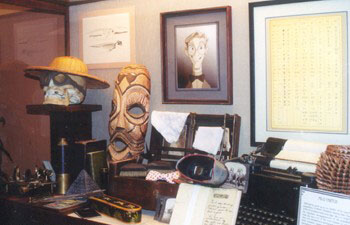 |
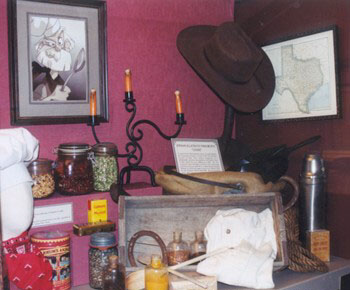 |
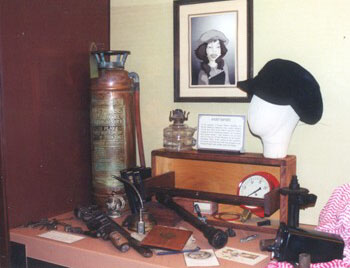 |
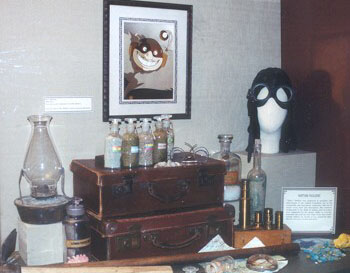 |
"20K" CLOSING CREATES OPPORTUNITY FOR NEW WDW RIDE
This brings us to September 1994 -- when Walt Disney World management quickly and quietly pulled the plug on the "20,000 Leagues" ride at the Magic Kingdom. Genuinely surprised at the public's impassioned outcry at the closing of this beloved Fantasyland attraction, WDW management at first denied that the subs were actually closed. For almost 18 months, all the company would admit was that "20K" was down for an extensive rehab.
Finally, in early 1996, Disney begrudgingly admitted the obvious: the Magic Kingdom's sub attraction wasn't ever going to re-open. Still, hoping to put the best possible face on the situation, they then announced that a "significant" new attraction was being designed to replace the late, lamented "20K." Only then did WDW management turn to WDI and say "You guys got any ideas?"
Luckily, they did. Based on guest surveys, Imagineering knew that WDW guests thought that the Magic Kingdom was long overdue for a new thrill ride. The last somewhat thrilling attraction that had been added to the park was the troubled "Alien Encounter" show back in 1995. Before that, you'd have to go all the way back to 1992 when "Splash Mountain" opened in Frontierland.
TWO VERY DIFFERENT TAKES ON "2OK" REPLACEMENT
WDI quickly divided into two schools of thought concerning this project : those who thought that any attraction that was proposed to replace the old "20K" ride had to be Jules Verne-ish in tone, and those who thought that any new thrill ride that was planned for this part of the Magic Kingdom had to be a good neighbor to Fantasyland and Mickey's Toontown Fair (ie: the attraction should be kid-friendly, fantasy-based and/or cartoony in nature).
Given this situation, WDI management felt that the best way to handle the "20K" problem was to put two different Imagineering teams to work on the project: one that would develop a Jules Verne-y sort of thrill ride, while the other would be tasked to come up with an attraction that would fit comfortably between Fantasyland and Mickey's Toontown Faire but still thrill guests.
The weirdest aspect of this decision is that WDI management didn't tell either design team that there was another group of Imagineers out there trying to come up with a new attraction for the "20K" site. Each team thought they were the only group within WDI working on the sub replacement project.
The Jules Verne group quickly worked their way through a pile of sci-fi based ride possibilities. Among the ideas that were -- for one reason or another -- eventually discarded was a "20K" themed motion based simulator (a ride idea that had originally been proposed by Tony Baxter 'way back in 1976 as a possible attraction to be featured at Disneyland's never-built-but-still-fondly-remembered Discovery Bay area) as well as an Americanized version of the Nautilus walk-through attraction from Disneyland-Paris.
Among the most difficult decisions the Verne group of Imagineers had to make was what to base their new proposed pseudo-sci-fi thrill ride. There were already numerous rides and attractions out there that were based on Disney's "20,000 Leagues Under the Sea" film ( Plus four or five other new "20K" based attractions that were already in the works for the "Mysterious Island" section of the Tokyo Disney Sea theme park. But that's another l-o-o-o-n-g story for another time ... Anyway ...). The Verne Imagineers wanted to come up with a ride concept that was bold, new and exciting that would grab WDW management's attention, but still have that old Jules Verne feel. Something that would actually top the old sub attraction, not seem like some pale replacement.
NEW ANIMATED FILM LEADS TO NEW RIDE SCENARIO FOR "20" REPLACEMENT
The Verne team screened all sorts of Disney sci-fi adventure films: In Search of the Castaways, The Island at the Top of the World, The Black Hole. Even Tron. Looking for something that might inspire a Verne-style attraction. None of these films panned out, though. None of them had the story elements necessary to provide a theme for a bold new thrill ride. Things were looking pretty bleak for this team of Imagineers for a while there ... Until someone in development at Disney Feature Animation clued the Verne group into a film they'd just put into production: Atlantis!
Atlantis was supposed to be something bold and new for Disney Feature Animation: a wide screen sci-fi animated adventure in the Jules Verne tradition. Directed by Gary Wise and Kirk Trousdale (the same team that rode herd on the creation of Beauty and the Beast as well as The Hunchback of Notre Dame), Atlantis would feature brave explorers, deep diving subs, giants squids, lost civilizations and -- best of all -- an exploding volcano.
It was that exploding volcano -- that figures prominently in Atlantis' explosive finale -- that the Verne team immediately zeroed in on. Here was that rarest-of-rare opportunity: the chance to actually propose a new thrill ride that could logically be housed inside a mountain. The Verne Imagineer team knew that WDW management had long been looking for a way to expand the Magic Kingdom's mountain range. Proposing that the "20K" replacement attraction could be built inside a smoking volcano would make it that much more likely that WDW management would immediately green light construction of the attraction.
Now that they had a dramatic new setting for their "20K" replacement, the Verne team of Imagineers had to figure out what sort of thrill ride their "Atlantis" based attraction would be. They didn't want to just copy pre-existing WDW thrill rides -- do another roller coaster rolling through the dark (a la Space Mountain) or another run-away train ( ditto Big Thunder Mountain). Particularly with all the cutting edge thrill rides that were being built around Orlando at Universal's Islands of Adventure, Sea World - Florida and Busch Gardens - Tampa, Disney was seriously looking for something different to add to the Magic Kingdom. An attraction that would put them back on top in the Florida theme park arena.
IT'S TWO - TWO - TWO COASTERS IN ONE!
With the hope that it might give them some ideas about what sort of ride to develop, the Verne team turned again to WDW's exit surveys. What they learned was that -- while guests really did want a new roller coaster built at the Magic Kingdom -- their favorite new ride at Walt Disney World was the Twilight Zone Tower of Terror at Disney / MGM Studios, an attraction that starts out as one sort of ride then mutates into something different. The Imagineers chewed on this info for a bit, then thought: What if we were to combine these two ideas? Create a ride that starts out as one roller coaster, then changes into another?
A few meetings with WDI R & D later, the Verne team of Imagineers had what they thought was a brilliant concept for a new Disney thrill ride. Their attraction would start off as a standard running-on-rails roller coaster. Midway through, the ride system would suddenly transform, changing into a hang-from-above coaster, similar to Busch Gardens - Tampa's Montu. The event that supposedly causes the vehicle to change? The volcano erupts as the guest is riding through it.
Now all this killer concept for a new Disney thrill ride needed was a killer name. Happily, one of the Imagineers on the Verne team remember the second name for the proposed Epcot "Mount Fuji" attraction.
And that's how the Atlantis-based attraction proposed for the old "20,000 Leagues" site at Walt Disney World's Magic Kingdom ended up being called "Fire Mountain".
A SECOND FLUME RIDE FOR THE MAGIC KINGDOM?
Meanwhile, the other team of Imagineers who had been tasked to come with a replacement for "20K" were also pouring over WDW guest exit surveys. They learned that one of the guests' favorite rides at the Magic kingdom was "Splash Mountain" in Frontierland. What intrigued the Imagineers was that though guests obviously loved "Splash", they'd also complain bitterly about the hour-long wait to get on the ride.
It seemed obvious that there was demand for an additional flume-type attraction at WDW's Magic Kingdom. A second ride like this would take the heat off of "Splash" and raise guest satisfaction during their visits to the Magic Kingdom.
But what sort of flume ride would fit at the corner of Fantasyland and Mickey's Toontown Fair? Something toony, obviously. But WDW management had specifically asked for a thrill ride to replace "20K", "Splash Mountain" is fun, but -- other than that last 5 story drop -- it's not really long on thrills. Charming, yes. But thrilling? Eh ...
So how do you combine toons with thrills? This team of Imagineers was stumped for a bit -- until they came across an internal document from Disney's Consumer Products division. It seems -- over the past few years -- one of the more popular new lines of merchandise introduced at the theme parks and the Disney Stores was one featuring the Disney Villains.
The Imagineers chewed on this info for a little bit. People like the Disney Villains. People like flume rides. Would it be possible to combine the two?
DISNEY VILLAINS INSPIRE NEW RIDE & WHOLE NEW LAND
For a while, this team of Imagineers struggled over deciding which Disney toon villain to base their proposed flume ride on. Which character was strong enough and memorable enough to build an entire attraction around? Maleficent? Chernabog? The Horned King? There are a lot of great Disney villains, but none of them lent themselves easily to a storyline that could be used to carry a whole attraction.
Then the Imagineers had a brain storm: Why limit themselves to a single Disney villain? Why not build a flume ride around ALL of the Disney villains?
And that's how the concept for "Villain Mountain" was born. (To be truthful, there is a second title currently floating around WDI as a possible name for this proposed attraction. As sort of a tribute to the original "Fantasia", some Imagineers would like to call the flume ride "Bald Mountain". Trouble is, initial marketing surveys suggest that Disney theme park guests don't really care for that name. They don't seem to get the "Fantasia" tie-in and/or the "Bald Mountain" name just seems to confuse them. "Would this attraction be sponsored by the Hair Club for Men?", one guest supposedly joked. Given that the names of proposed attractions can change numerous times before they make it off the drawing board ["Mount Fuji", "Atlantis" attraction, "Fire Mountain" ... you get the idea], for the purposes of this article, we're going to stick with the proposed attraction's first, though admittedly much more generic sounding name: Villain Mountain).
This concept really caught fire at WDI. The Imagineers working on the toony version of the "20K" replacement ride just came up with idea after idea for this proposed attraction. So many ideas -- in fact -- that "Villain Mountain" spilled over from being a proposal for a single new thrill ride to a concept for a whole new land at WDW's Magic Kingdom.
A QUICK STROLL THROUGH THE DARKER SIDE OF THE MAGIC KINGDOM
Roughly, the proposed layout for the "Villain's Mountain" area is as follows: guests could enter this new land at the Magic Kingdom from Fantasyland via a gateway that would be built between the old Pinocchio Haus Restaurant and the new "Ariel's Grotto" meet-and-greet area. Wandering down a dark twisty cobblestone street, they'd find a grubby collection of villain-themed shops and restaurants. There'd be numerous costumed Disney villains lurking about, ready to sign autographs, pose for pictures and/or give a little attitude. There might even be a "Dumbo" style attraction built around the Ursula character from "The Little Mermaid", on which guests would fly through the air while caught up in the Sea Witch's tentacles (A version of this attraction is already slated for construction in the "Mermaid Lagoon" section of Tokyo Disney Sea.)
But the centerpiece of this proposed addition to the Magic Kingdom would be Villain Mountain. A craggy, sinister peak modeled after Chernabog's perch from "Night on Bald Mountain", scary laughter and screams would echo out of the caves that are cut into all sides of the mount.
Though the proposed attraction's storyline remains (even at this late date) a little vague, this much is known: All of the great Disney villains have supposedly gathered deep inside the mountain for a criminal convention to determine who's the creepiest creep. Guests climb into dark longboats -- modeled after the one Hades used in "Hercules", when he was crossing the River Styx -- to journey through the mountain. As they board, the guests are cautioned not to disturb the fiends. But -- of course -- the guests accidentally interrupt the gruesome gathering. Angered, the Disney Villains pursue the guests throughout the mountain, popping out and scaring them at various turns. The only way back to safety? Down the perilous flume at the front of the mountain.
According to the current plan, guests would board the "Villain Mountain" ride from inside the new land toward the backside of the mountain. The "splashdown" area for the flume would be out front in the "20K" lagoon, facing the new "Many Adventures of Winnie the Pooh" attraction. The boats would then float through the lagoon, curving back into the mountain to the load / unload area where guests will exit through the inevitable "Villain Mountain" image capture ("Get your picture here!) and gift shop area.
Why have the proposed ride's splashdown area facing into the park? So that guests -- who are walking past the lagoon on their way to Tomorrowland, Fantasyland and Mickey's Toontown Fair -- would see folks screaming down the flume and think "How do I get on THAT ride?" This would then compel them to enter this new part of the park, exploring all the new shops and restaurants before finally making their way to the entrance of the "Villain Mountain" attraction.
Guests exiting the attraction could make their way out Disney's Villain Village by retracing their steps into Fantasyland or by wandering down into Mickey's Toontown Fair. (There's also some talk of creating a transition zone between Toontown Fair and "Villain Mountain" featuring Mickey's old nemesis, Black Pete ... But that's on the WDI "wish list," not a "must have" piece of this proposed addition to the Magic Kingdom.)
SO WHICH MOUNTAIN GETS BUILT? ..... AND WHERE?
The Imagineers felt that they really had a winner with "Villain Mountain". Of course, so did the WDI team that came up with the "Fire Mountain" ride idea. So which concept would WDW management decide to go with?
Initially, they couldn't decide at all. Each of these proposed ride concepts was so distinct, so strong that WDW management was dazzled by both. Either would make a great addition to the Magic Kingdom. Each was an attraction that was guaranteed to drive up attendance as well as provide a strong hook to use in promoting the park.
But -- upon closer inspection --some problems arose with the "Fire Mountain" concept. With its huge cauldara belching smoke and steam, rumbling day and night, this "Atlantis" based attraction didn't seem like that great a fit with Fantasyland and Mickey's Toontown Fair. There were also concerns that the tropically themed volcano would just look odd poking up from behind Cinderella's Castle.
But WDW management felt that "Fire Mountain" was too good a ride concept to just dismiss outright. So it really didn't fit in Fantasyland. Was there anywhere else in the Magic Kingdom that this proposed thrill ride would work?
Actually, yes. With little or no change to its ride building and outer theming, "Fire Mountain" looked like it would make a great addition to Adventureland. Just to be sure, though, the Imagineers did height tests for the proposed attraction. They raised a set of balloons behind "Pirates of the Caribbean", then walked around the Magic Kingdom to see if the proposed height of the attraction would make it visually intrude into the theming of other parts of the park. The Imagineers even checked out the view around Seven Seas Lagoon. The general consensus was that "Fire Mountain" would fit in fine in that corner of the Magic Kingdom park. But -- when viewed from the beach at the Polynesian -- the smoking volcano in the distance made for a truly inspired addition to that resort's theming.
Assured that "Fire Mountain" would fit in the new location, WDW management found themselves with a real dilemma : they now had two killer attractions that they could add to the Magic Kingdom. Which should they build?
IT'S UP TO EISNER: FIRE OR FIENDS?
Not quite sure what to do here, WDW management did the smart thing. They bumped this decision back to Burbank - to let Eisner and his brain trust sort out which attraction to add to the Magic Kingdom. (Why was this the smart move? Given the astronomical costs involved in building either of these proposed attractions, WDW's managers hoped that Eisner would see "Fire Mountain" & "Villain Mountain" and get excited. An excited Michael might open up the Disney Company coffers, freeing up the huge wads of cash necessary to build rides like these.)
Their ploy worked. Eisner liked what he saw and tentatively agreed to put both attractions into production. However, given the logistics involved with building " Villain Mountain ( which meant adding a whole new land to the Magic Kingdom to support the story of the proposed attraction ), it was decided that "Fire Mountain" would be built first. (Promotionally, this made sense too. If it was built fairly quickly, the "Fire Mountain" attraction would benefit the residual heat left over from the release of "Atlantis", the feature film that the ride would be based on.)
Under the tentative construction timetable, initial site prep and survey work for "Fire Mountain" would begin this summer. The attraction would then be officially announced this fall, as part of WDW's annual press extravaganza (Usually held over the last week of September / first week of October as part of the resort's birthday celebration). Construction would hopefully start in January 2000 and -- barring any unforeseen delays -- be completed by the summer of 2001. Following two or three months of test and adjust on the attraction, "Fire Mountain" would officially be unveiled October 1st, 2001 as part of WDW's 30th anniversary celebration.
This timetable (which is subject to change) represents WDW management's ideal for what will happen with "Fire Mountain". By having the attraction up and running for the start of WDW's 30th anniversary, Disney would then have a huge new ride as well as a great hook to build that year's promotional campaign around. Among the many ad campaign concepts that have been tied to the project is "Disney World Explodes with Excitement!" The artwork that accompanies the proposed ad campaign shows a roller coaster car full of happy guests being blasted out of an erupting Fire Mountain.
VILLAIN MOUNTAIN TO FOLLOW IN 2004 ... MAYBE
What about Villain Mountain ? Not to worry. Eisner was evidently just as excited about that proposed attraction. (He supposedly asked that the "Villain Mountain" team from Imagineering to make sure that the Disneyland, Tokyo Disneyland and Disneyland - Paris management teams were all made aware of the proposed ride concept. Why for? So that these other Disney resorts could consider adding "Villain Mountain" to their parks as well. Eisner seems to think that "Villain Mountain" -- like "Big Thunder" and "Splash Mountain" -- could be an attraction that could work at Disney theme parks in any corner of the globe.)
The construction timetable of "Villain Mountain" is a lot vaguer, though. WDW management would like the "20K" replacement ride in place as soon as possible. But the usual rule of thumb concerning hugely expensive attractions at the Disney resorts is that each theme park gets a new one built every three to four years. If this holds true, the earliest "Villain Mountain" will rise up out of the old "20K" lagoon is 2004.
But WDW management will definitely keep the pressure up on WDI concerning "Villain Mountain". They view this attraction -- as well as the new Magic Kingdom land built around the ride -- as finally giving WDW a legitimate entry into the lucrative Halloween theme park market.
For almost 10 years now, WDW management has stood by each October and fumed as Universal Studios Florida lured Disney theme park guests off property to take part in their "Halloween Horror Nights". This annual fall fright fest has turned into a real cash cow for Disney's competition. Universal has gone from offering just two weekends of Halloween festivities back in 1990 to now almost a full month of frights.
WDW has wanted to snag a bigger chunk of this seasonal theme park market for years now. But the company's family oriented image has long prevented the Mouse from coming up with a really successful Halloween theme park event. To date, the best WDW's Special Events Office could come up with was "Mickey's Not-So-Scary Halloween Party", a mild kid-friendly celebration held annually at the Magic Kingdom. This two night special ticket event -- which is usually presented on the last weekend of October -- rarely sells out. Attended mostly by families staying in WDW resorts, it doesn't pull in anywhere near the pile of cash for the Disney Company that Universal's " Horror Nights generates for Seagrams/MCA.
NEW RIDE MAY LEAD TO REVAMPED WDW HALLOWEEN CELEBRATION
But now, with a new Disney villain-themed land and attraction on the drawing boards, WDW's Special Events Office might finally have something to work with. Something that they could build on to create a truly memorable Disney Halloween theme park event. Forget all that "Not So Scary" stuff. Imagine an event where -- after dark -- the Disney villains take control of the Magic Kingdom. There'd be a special night-time parade featuring the Disney villains and the "Nightmare Before Christmas" characters as well as a spectacular midnight fireworks display. With an event like this, Disney might finally be able to give Universal a real run for the money -- Halloween-event-wise.
So don't expect WDW management to give up on the "Villain Mountain" idea anytime soon. Here's too much money to be made off this proposed attraction to leave it lie too long. They'll keep hammering away at Eisner until he finally gives in and green lights construction on the attraction.
So -- if you follow the old WDW formula (At least three to four years between major new attractions being built at each of the Florida theme parks) -- it's likely that "Villain Mountain" won't officially be announced 'til the fall of 2004. Again, with site prep and construction time, "Villain Mountain" and its surrounding themed area probably won't open 'til the summer of 2006. Then, if you factor in test and adjust, "Villain Mountain 's" grand opening probably won't occur 'til the last week of September / first week of October of 2006 -- as part of WDW's 35th anniversary celebration.
Now keep in mind that all this info is subject to change. If you factor in the hard lessons learned during the "GM Test Track" debacle (Just 'cause an attraction gets built doesn't mean that it will be ready to roll on its announced opening day. Sometimes it can take as long as 18 months to get all the bugs out), all projected opening dates are subject to change.
But what's important to remember is that Eisner and WDW management are
really enthusiastic about both " Fire Mountain " and "Villain Mountain".
Provided that there are no sudden management changes in Burbank and/or
Lake Buena Vista, these attractions should be built at WDW's Magic Kingdom.
"Fire Mountain" first, following -- 3 to 5 years later -- by "Villain Mountain".
|
||||||||||||